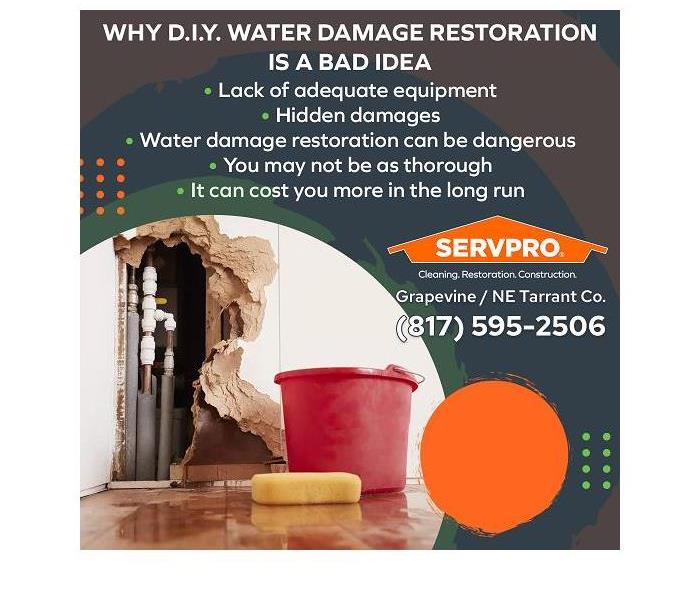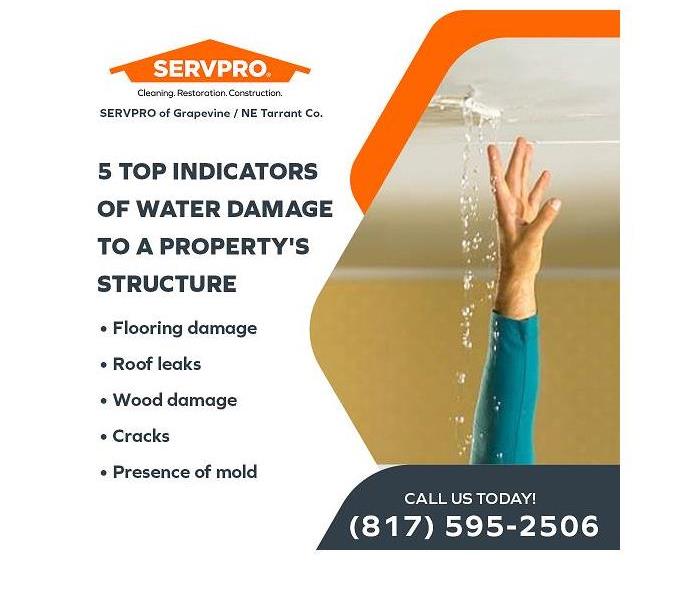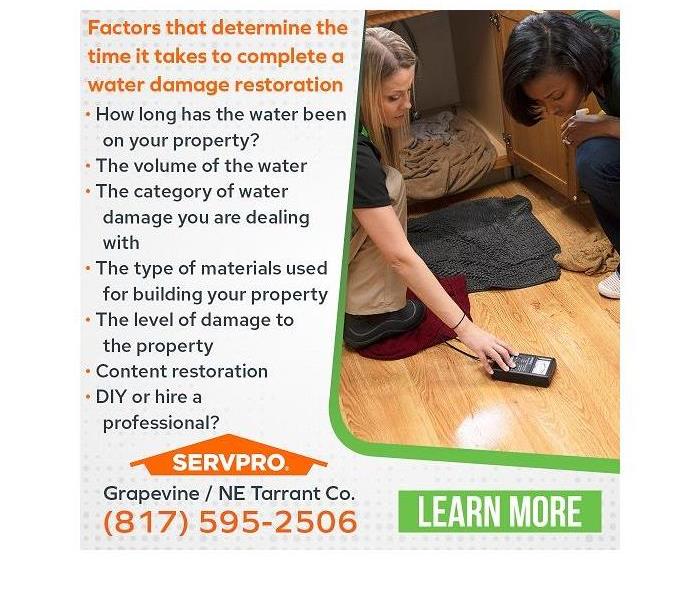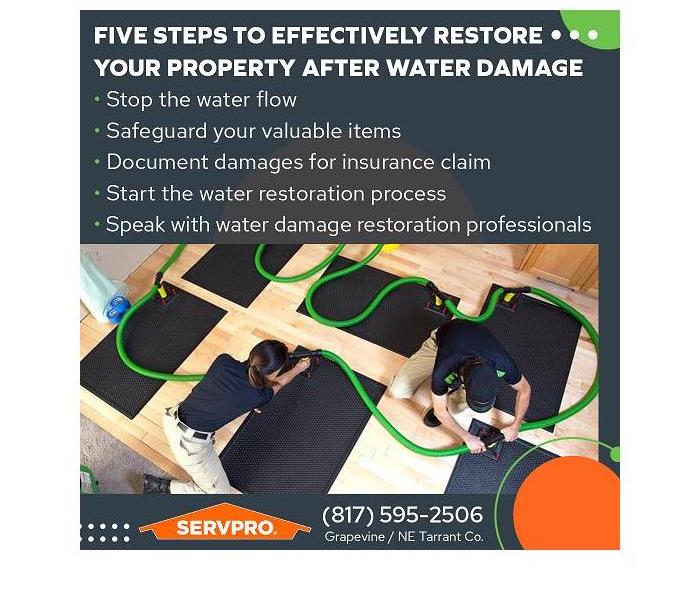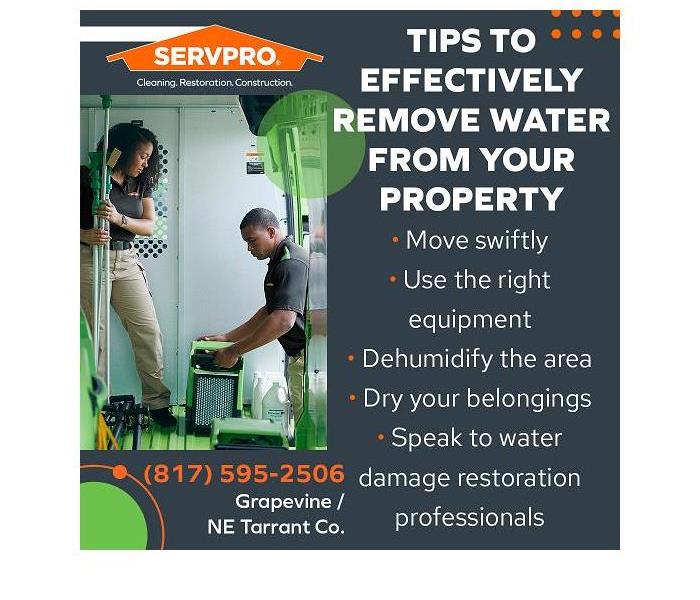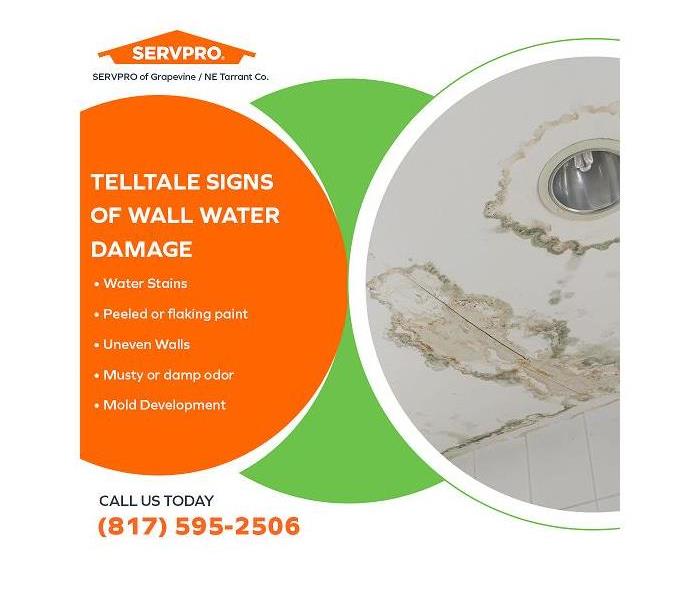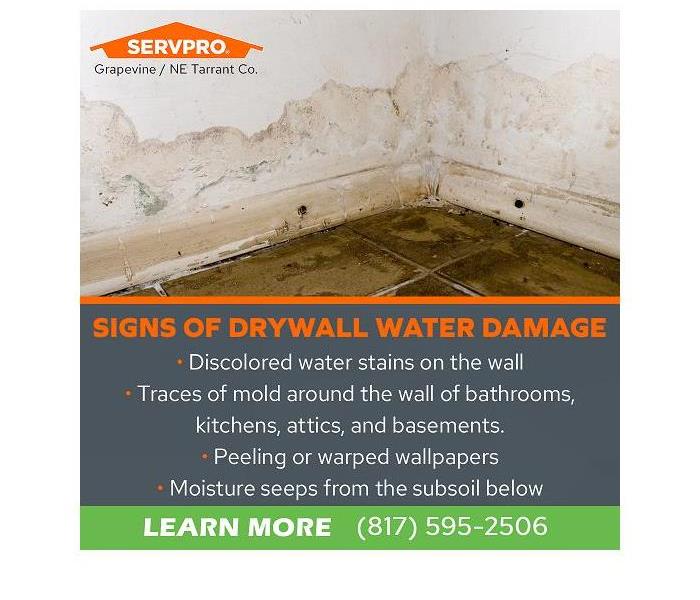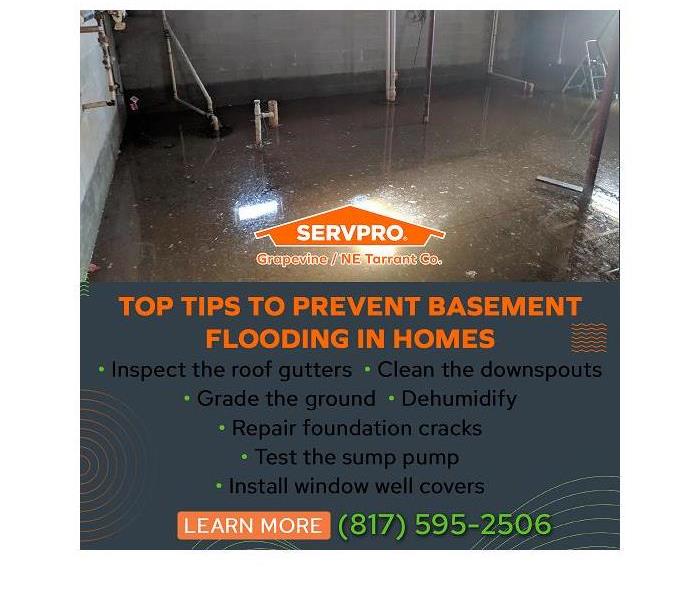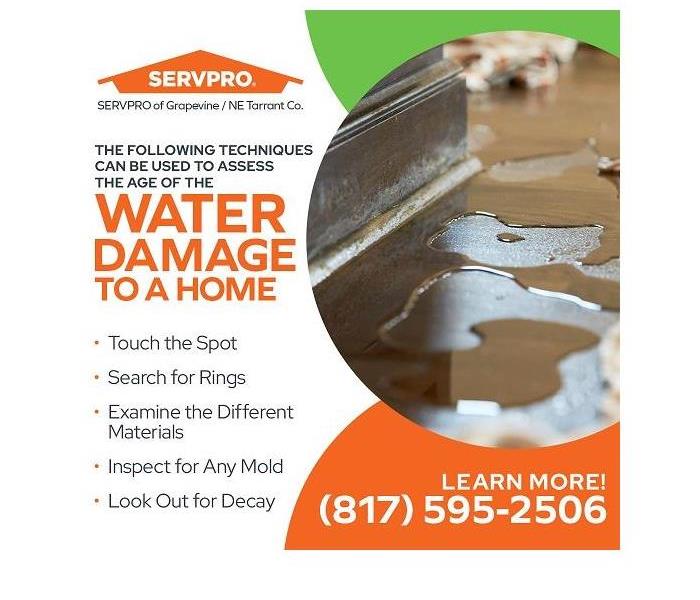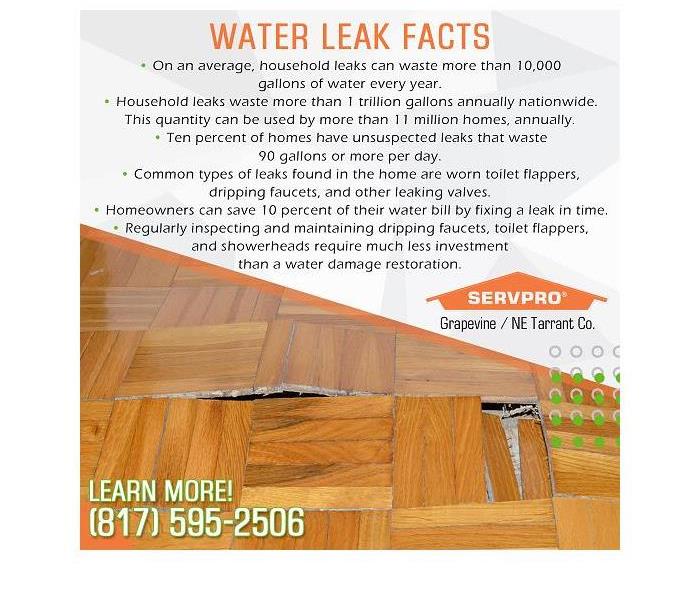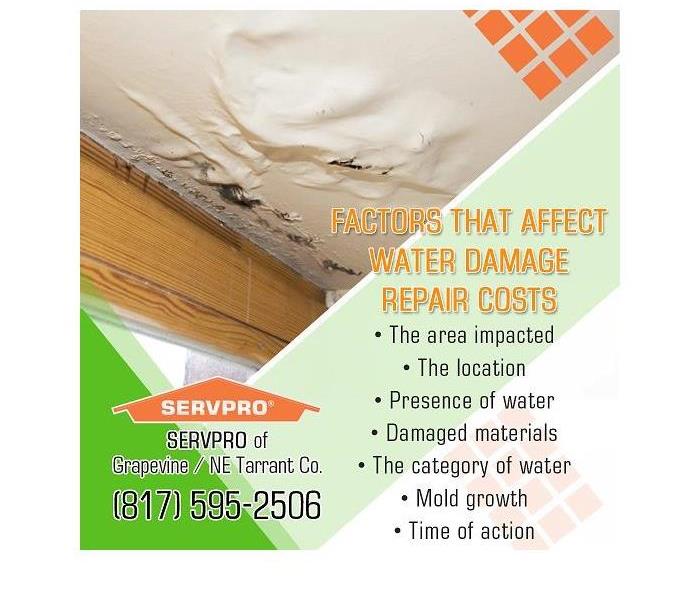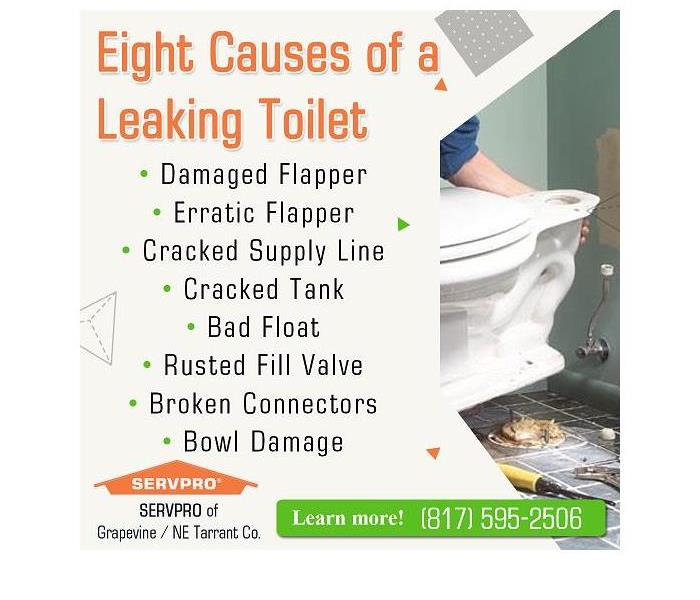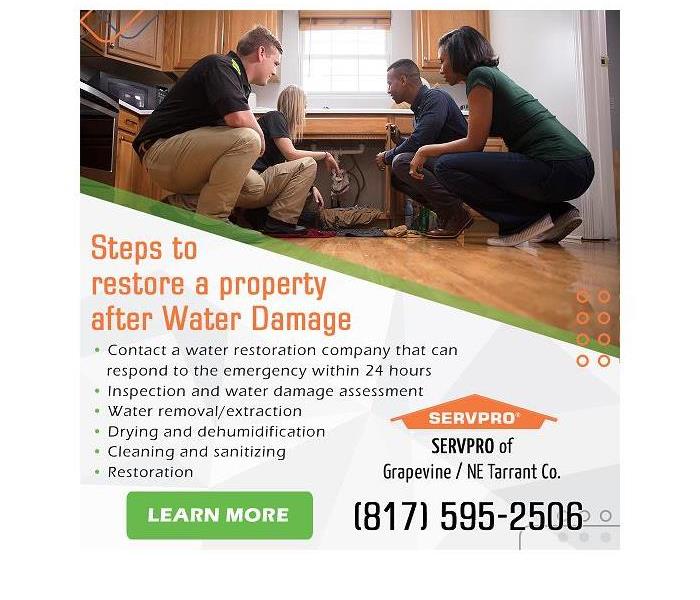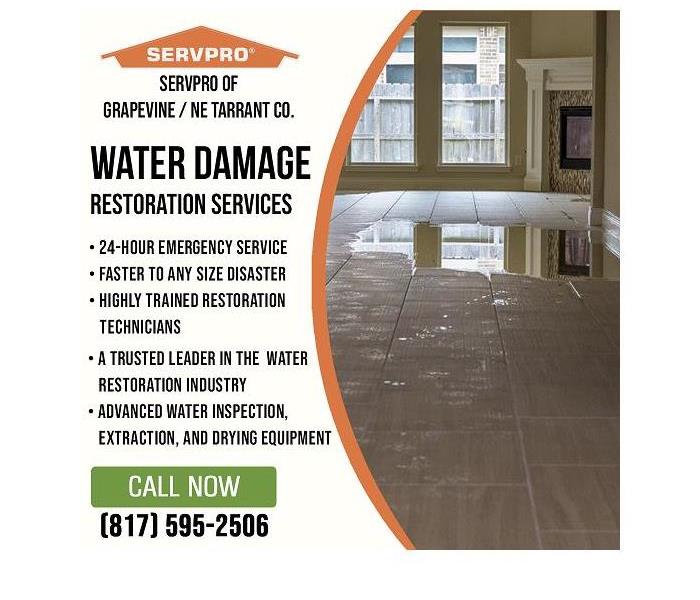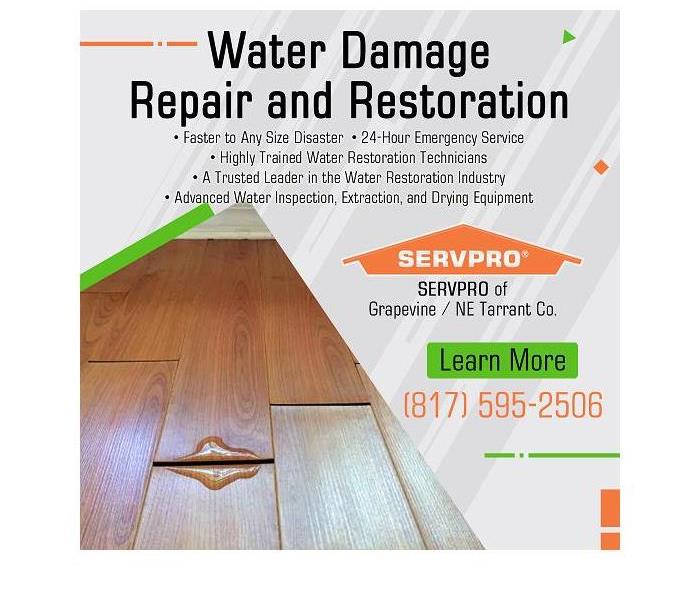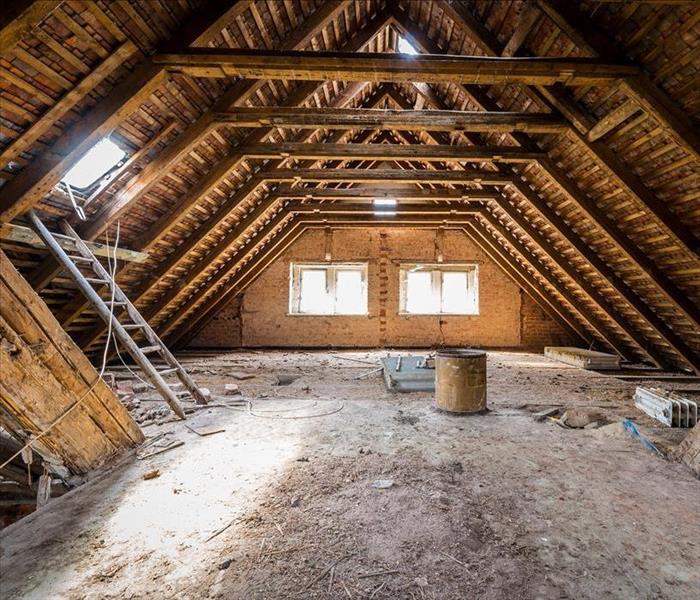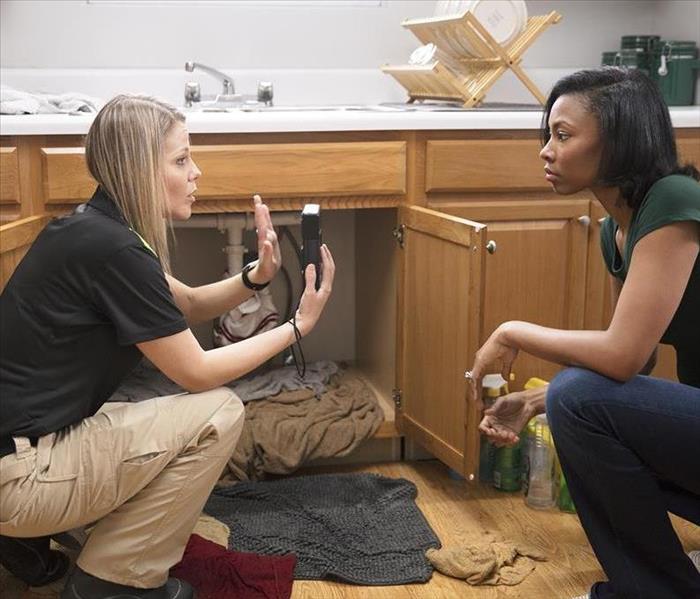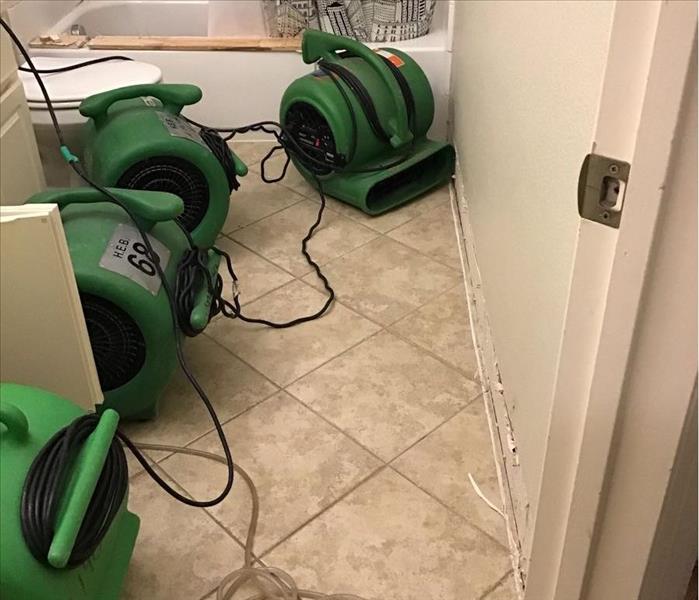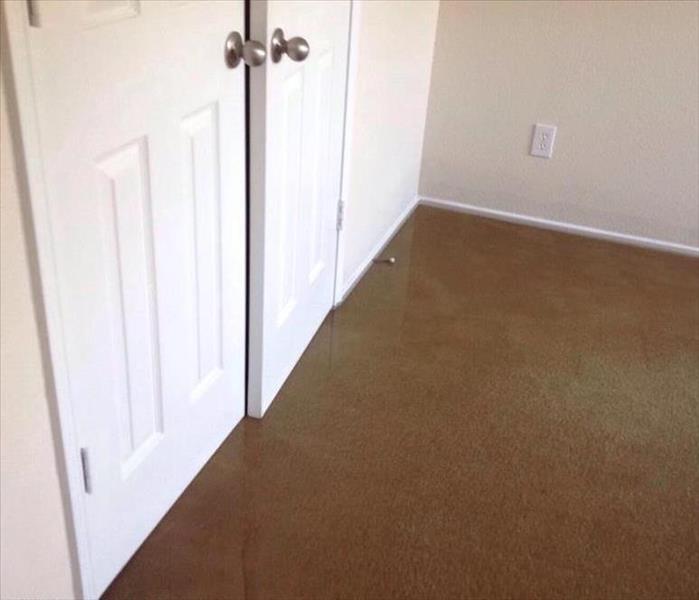Archived Water Damage Blog Posts
The Importance of Immediate Water Damage Restoration: Preventing Long-Term Damage
7/12/2024 (Permalink)
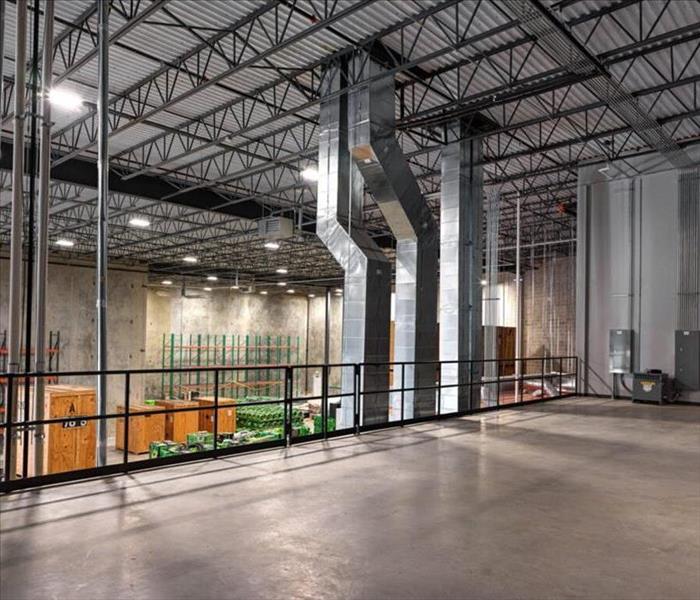 Team Shaw warehouse in Grapevine
Team Shaw warehouse in Grapevine
Water damage can wreak havoc on your property in a matter of minutes. Whether it's due to a burst pipe, flooding, or an appliance malfunction, immediate water damage restoration is crucial. Delaying this process can lead to severe consequences that extend far beyond the initial damage.
Why Quick Action Matters
When water infiltrates your property, it begins to seep into walls, floors, and furnishings almost immediately. Within just a few hours, wood can swell, metal can rust, and mold can start to form. The longer water is left untreated, the more extensive and expensive the damage becomes. This is why immediate restoration is essential.
Steps to Take Immediately
- Turn Off the Water Source: If the water damage is due to a burst pipe or an appliance leak, turn off the water supply to prevent further flooding.
- Turn Off Electricity: Water and electricity are a dangerous combination. Turn off the power to the affected areas to avoid electrical hazards.
- Remove Excess Water: Use mops, towels, and wet/dry vacuums to remove as much water as possible.
- Call a Professional Restoration Service: Professional water damage restoration companies have the tools and expertise to thoroughly dry and restore your property.
Preventing Long-Term Damage
Immediate water damage restoration not only addresses visible water but also involves drying out hidden moisture. This is crucial in preventing long-term issues like:
- Mold Growth: Mold can begin to grow within 24-48 hours. Once it starts, it spreads quickly, posing health risks and further damaging your property.
- Structural Damage: Water can weaken the structural integrity of your home, leading to warped floors, compromised walls, and damaged foundations.
- Electrical Damage: Water can damage electrical systems, leading to shorts, fires, and costly repairs.
- Health Risks: Stagnant water can become a breeding ground for bacteria and pathogens, posing serious health risks.
Conclusion
Don't underestimate the importance of immediate water damage restoration. Quick action can save you time, money, and stress in the long run. By addressing water damage promptly, you can prevent mold growth, structural damage, and other long-term issues, ensuring your property remains safe and secure.
SERVPRO of Grapevine/NE Tarrant Co. outlines the dangers of DIY water damage restoration
12/14/2022 (Permalink)
Blog Summary: SERVPRO® of Grapevine/NE Tarrant Co. outlines 5 reasons why property owners should leave water damage restoration to professionals.
DIY projects have gained enormous popularity thanks to the abundance of information now readily available online. So, many people are often compelled to take the DIY route when faced with water damage in their homes or businesses. Some think it will save them money, while others do it because it seems easy.
But, while it may seem intriguing, undertaking water damage restoration on your own is the wrong approach and could cost you more in the future.
The restoration specialists at SERVPRO of Grapevine/NE Tarrant Co., a leading water damage restoration company in Watauga, TX, have outlined the following five reasons to avoid DIY water damage restoration.
1. Lack of adequate equipment
Adequate water damage restoration requires several tools, including water pumps, industrial fans, dehumidifiers, moisture detectors, and other tools explicitly created to dry out homes and other structures after water damage.
As a property owner, you most likely don’t have these tools. While you could hire some dryers and dehumidifiers, you may not be able to use them properly without the necessary skills and training.
Certified restoration specialists like those from SERVPRO of Grapevine/NE Tarrant Co. have these technical tools and equipment and use them to remove any standing water and adequately dry up the whole space.
2. Hidden damages
Water damage restoration isn’t a straightforward process since you are dealing with water, and it can enter anywhere. So, there’s a high chance that the water will enter places you may not bother to check. It can build up below the carpet, inside walls, and in other places.
The issues may get worse if you do it yourself and don’t accurately assess the extent of the damage.
Water damage restoration specialists know the areas the water is likely to enter and often use moisture sensors to find and dry hidden moisture.
3. You may not be as thorough
Most property owners find simple DIY projects intriguing since they have complete control over the outcome. But that’s not the case with water damage. Water damage restoration is not only time-consuming but also requires a high level of focus and diligence.
You must continue drying and cleaning until every moisture has been dried up. Improper drying can cause structural damage and mold growth in your attic and other hidden areas.
4. It can cost you more in the long run
Property owners often choose DIY water damage restoration to save money, but it can cost them more. Ineffective water damage restoration will put your property at risk of structural damage over time.
For instance, if a wood board soaks up water and isn’t dried adequately, it can lead to rot, affecting the whole property structure and resulting in a massive repair bill.
5. Water damage restoration can be dangerous
There are several risks involved with water damage restoration, especially flood damage, including electrocution, contaminated water, and structural damage. Although it is uncommon, structural damage is something to be mindful of. Sometimes the intensity of a flood or simply having water inside your property can damage the structure to the point where you are at risk.
Also, floodwater typically contains dangerous bacteria and microbes that, if ingested or touched, can result in serious illnesses.
Get professional water damage restoration in Watauga, TX
The skilled specialists at SERVPRO of Grapevine/NE Tarrant Co. can handle all your water damage needs. They are a leading water damage restoration company with the experience and tools to restore your home or business properly after a water damage incident.
Their team is trained to find hidden water spots and will give the task the time and effort required to ensure your property is properly dry. They are available 24/7 and can come to your place within hours to start the restoration.
Give SERVPRO of Grapevine/NE Tarrant Co. a call at (817) 595-2506 to speak to a water restoration specialist.
SERVPRO of Grapevine / NE Tarrant Co outlines five factors that indicate water damage-induced structural damage
11/24/2022 (Permalink)
Blog Summary: Did you experience water damage in your home or business? Here are the signs that it's damaging your property structures.
Water can cause so much damage to your property within hours, and it gets worse every moment it's left unchecked. Even tiny drops of water can damage the structure of a property, requiring expensive repairs.
The team at SERVPRO® of Grapevine / NE Tarrant Co shares 5 top indicators of water damage to a property's structure.
1. Flooring damage
Water can permeate wooden, cement, and even tiled floors. If water gets into your floor and isn't dried out, it can lead to cracking or collapsing. This situation may be more difficult to notice if you have a carpet covering the floor.
The dishwasher and refrigerator are also high-risk places for floor water damage since these appliances are prone to leaks.
2. Roof leaks
Water damage to the roof can be challenging to detect since the roof damages are often obvious. The damage will only become evident when it has worsened, resulting in missing shingles, stains on the ceiling, roof tears and cracks, or rusted roof flashings.
You should repair roof damage as soon as you notice it to protect your property from further damage from the elements.
Also, make sure to look for water damage in your attic. Your rafters risk rotting and softening if the leak is fixed only after some time. Leaky roofs can also lead to electrical circuit issues, damaging the wires or, even worse, causing electric sparks.
3. Wood damage
Whether you've recently experienced flooding or something smaller, like a pipe break, direct contact with the water can ruin the wooden components of your property, like your floor.
To repair swollen, water-damaged wood, start letting it dry by placing it outside in the sun, in a well-ventilated space, or by placing electric fans blowing air over it. Once the wood has dried, you can figure out how bad the damage is and then sand and oil it.
4. Cracks
A crack can indicate that your property's foundation is shifting due to water damage. Small hairline cracks are often not a big deal since the foundations of most properties contain a few.
However, keep an eye out for tiny cracks on the floor and between the ceiling and doors. Large horizontal fissures across walls indicate that your building may have structural issues due to water damage.
5. Presence of mold
Mold is a major indication of water damage and can damage your property's structure. Typically, mold can grow within 24 hours after water damage and can damage your drywall, ceiling, and attic.
Besides apparent water damage incidents, mold typically appears in areas with a lot of moisture, like the kitchen, bathrooms, and laundry rooms.
What should you do?
It's essential to hire a water damage professional to handle water damage incidents so it's done correctly.
Also, hire a water damage specialist if you notice any sign of structural damage due after a water damage incident. They have tools like moisture detectors that can locate moisture on any structure, from concrete to wood, so that it can be appropriately restored.
Get professional water damage restoration services in Grapevine
SERVPRO of Grapevine / NE Tarrant Co offers professional water damage restoration services for homeowners and businesses in Grapevine. They have years of experience and the right tools to do the job efficiently to ensure no water is left behind.
When you hire SERVPRO of Grapevine / NE Tarrant Co, you can rest assured that you won't have to deal with any form of structural damage, as they will expertly dry off any moisture. They can also fix your damaged ceilings, drywall, and other Structural damages.
Call SERVPRO of Grapevine / NE Tarrant Co at (817) 595-2506 to get a free quote.
SERVPRO of Grapevine / NE Tarrant Co explains how long it takes to complete water damage restoration
10/15/2022 (Permalink)
Blog Summary: SERVPRO of Grapevine / NE Tarrant Co answers the questions about "how long it takes to complete water damage restoration.’
Water damage is a significant risk that every homeowner faces. It can come from a faulty appliance, excessive rainfall, sewage backup, a pipe burst, or even a roof leak.
When water damage happens, everyone wants to get over it quickly and move on with their lives, but it’s never that straightforward.
SERVPRO® of Grapevine / NE Tarrant Co is a leading water damage restoration company in Southlake. Their restoration specialists have outlined the following factors that determine the time it takes to complete a water damage restoration.
1. How long has the water been on your property?
Like any other liquid, water permeates and weakens any material that comes in contact with it. So if you have standing water on your property for an extended time, it will take longer to properly dry the water as the material will have soaked in a lot of it.
That’s why it’s advisable to call for water damage restoration services once you notice any incidents to prevent extensive damage.
2. The volume of the water
As expected, more minor water damage incidents from appliances and roof leaks take a shorter time to address compared to larger ones from flooding.
When dealing with water spills from your fridge or air-conditioning, you’ll only need to clean it up and dry that area. However, when your home is flooded, you’ll have more water to remove and a wider area to dry, which will take more time.
3. The category of water damage you are dealing with
There are different categories of water damage depending on the level of cleanliness. So if you are dealing with a rainfall-induced flood, the water will be dirtier than water from a leak, and the cleaning will be more extensive.
It is even worse if it’s a sewage backup, as the process will take longer to ensure your property is properly cleaned, disinfected, and deodorized.
4. The type of materials used for building your property
If your property were constructed with porous materials like cardboard that absorb water quickly, it would take longer to restore than concrete walls.
The water damage restoration expert must ensure every moisture is dried off to prevent mold growth.
5. The level of damage to the property
Was any part of your property damaged in the process? Strong storms can destroy your roof and walls and let water into your home. Leaks can stain your walls and ceiling, so you’d need to replace them. Floods can damage your property’s structure, requiring replacement.
Some water damage restoration companies offer property reconstruction, while others can help link you with the right rebuilding expert. In all, the level of damage to your home will determine how long the rebuilding/restoration process will take.
6. Content restoration
Many restoration professionals offer content restoration, which involves cleaning and drying affected belongings to return them to their original state. This is part of the overall restoration process and can take a little while to complete.
7. DIY or hire a professional?
Water damage needs to be taken care of quickly and effectively, so it’s recommended to work with experts. These experts have the tools and experience to clean up and dry up your space and belongings promptly.
If you decide to handle the water damage yourself, it will take longer to complete since you might not have the tools and obviously don’t have the experience for it. What a trained water damage expert might take hours to complete might take a homeowner days to do.
Get professional water damage restoration services in Southlake
SERVPRO of Grapevine / NE Tarrant Co offers professional water damage restoration services in Southlake, TX. Their team is experienced in handling water damage of every category and type.
Call SERVPRO of Grapevine / NE Tarrant Co for residential or commercial water damage restoration at (817) 595-2506 to get a free quote.
Expert outlines the five steps to restoring your property after water damage.
9/14/2022 (Permalink)
Blog summary: Are you faced with flooding or any type of water damage? Here are the steps to effective water damage restoration.
Homeowners and businesses all over the world are faced with the challenge of water damage. Water damage of any magnitude, whether from a large flood or a small pipe leak, can seriously damage your property's foundation and your way of life if it is not dealt with immediately.
The water damage restoration professionals at SERVPRO of Grapevine / NE Tarrant Co. have years of experience handling water damage and helping homeowners and businesses in Grapevine, TX, quickly return to their homes after water or fire damage.
They’ve outlined these five steps to effectively restore your property after water damage.
1. Stop the water flow
When faced with a water damage situation, the first thing to do is find the source and stop the water flow. It will be useless to start the restoration process when the water is still flowing. If it’s a pipe burst, find the water main and turn it off.
If you don't know where your water shutoff valves are, try to find them because most household water damage is caused by water heater or water line leaks.
Ensure you first turn off the electricity in the building before going in to find the water source.
2. Safeguard your valuable items
Move unaffected and water-soaked belongings away from the flooded areas of your home to prevent further damage. If you have expensive furniture, quickly remove it from the area to prevent further decay and mold development. Remove pricey electronics and any other expensive or irreplaceable belongingsfrom the affected areas that the water could damage.
3. Document damages for insurance claim
Getting insurance claims is an essential part of any water damage restoration process. Many people have flood insurance, which may even be mandated by law in certain places. If you have this kind of insurance coverage, you must document the damages for your insurance claim.
Ensure to take pictures of all damage before you start the water damage repair process in a flooded home. The images will help determine your claim as a water damage situation needs to be taken care of immediately.
Ask your homeowner's insurance provider if you aren’t sure whether your policy covers water damage. Retain whatever damaged items you can as proof of the loss, especially if they are expensive.
4. Start the water restoration process
The water damage restoration process starts with extracting any standing water. This should be done within minutes to hours after it's safe to go into the house and the water source has been turned off. Remove damp items and take them outside so you can clear out all the water.
This is best left to professional water damage restoration companies like SERVPRO® of Grapevine / NE Tarrant Co. However, if you do it yourself, wear appropriate safety gear like hanging gloves and water-resistant boots.
Once you’ve cleared the water, the next step is to dry and dehumidify the affected areas before restoring your properties.
5. Speak with water damage restoration professionals
It’s never advisable to try to restore water damage on your own. Only qualified experts can access the specialized tools and knowledge needed to safely and effectively tackle water damage. Inadequate restoration will eventually result in the growth of mold and rot, raising the cost of future repairs.
Work with SERVPRO of Grapevine / NE Tarrant Co
SERVPRO of Grapevine / NE Tarrant Co. offers quick and effective water damage restoration services to residents and businesses in Grapevine, TX. Their team of IICRC-certified technicians is available around-the-clock to offer emergency water mitigation and water damage restoration services to stop further damage and restore your property.
They employ the most up-to-date tools and methods to guarantee a highly efficient restoration process.
The water restoration professionals at SERVPRO of Grapevine / NE Tarrant Co. are waiting to hear from you.
Call them at (817) 595-2506 to learn how they can help you.
Expert explains the steps for efficient water removal
9/14/2022 (Permalink)
Blog Summary: Are you confronted with water damage? Here's how you can effectively remove water from your property.
Removing standing water is the first and most essential part of an effective water restoration process to mitigate water damage. Clearing the standing water and drying any hidden water will protect the structural integrity of your property and stop mold growth.
However, water removal can be quite challenging. Depending on the level of water, you may need industrial pumps to get rid of any standing water and high-volume fans and dehumidifiers to dry out any hidden moisture.
SERVPRO® of Grapevine / NE Tarrant Co. is a leading water damage restoration company in Grapevine. They've removed standing and hidden water from several homes and businesses, restoring them to their preloss stage.
The water restoration professionals at SERVPRO of Grapevine / NE Tarrant Co. have outlined the following actionable tips to effectively remove water from your property.
1. Move swiftly
How fast you act when faced with a water damage situation can determine the level of damage you’ll experience. Call a water damage restoration company like SERVPRO of Grapevine / NE Tarrant Co. once you notice any signs of water damage. They'll arrive at your property quickly and help you handle the restoration process, including water extraction and drying.
If you want to work alone, you must first turn off your electricity unit before starting the water removal. Also, wear protective gear such as waterproof gloves and boots to protect yourself.
2. Use the right equipment
Using the proper equipment is the surest way to ensure you do a good job of removing all the water from your home. While depending on fans and sunlight to dry up affected areas can be great, it doesn't always dry out all the water, and you may end up with moisture remaining inside your property's walls.
Industrial pumps and fans are more effective at extracting and drying up a water-damaged area, especially if you are dealing with a flood. Water damage restoration professionals also use moisture detectors that allow them to find hidden moisture that has gone unnoticed.
3. Dehumidify the area
It's important to get rid of any moisture in the air since evaporation raises humidity levels. Industrial models are the best dehumidifiers for water removal since they operate more quickly and effectively.
Opening doors and windows is also a great idea if you live in a dry area where the outside humidity is lower than the inside, but make sure to close it if the outside humidity increases.
You could turn on the heat to speed up the drying process if your furnace and air conditioning equipment were not flooded. Warm air also dries things more thoroughly.
4. Dry your belongings
Water removal doesn't end with drying the building. You also need to dry your belongings to restore them to their preloss state. Clean your furniture, rugs, and other items, and then dry them with a fan or sunlight to eliminate signs of water damage.
5. Speak to water damage restoration professionals
Calling a water damage restoration company for help is one of the best things you can do if faced with a water damage situation. Water restoration professionals have the equipment and expertise required to extract water quickly and restore your home and belongings.
They also reduce the likelihood of mold growth and stop further damage that could cost you more in the future.
Professional water damage restoration is available in Grapevine, TX
Have you experienced water damage in your Grapevine, TX home or business? SERVPRO of Grapevine / NE Tarrant Co can help. They have a team of experienced and licensed water damage restoration experts that can handle damages of all sizes. They have the tools and expertise to quickly clear out water from your property, locate and dry out any hidden moisture, and restore affected belongings.
SERVPRO of Grapevine / NE Tarrant Co. is IICRC accredited and is available 24/7 to help you handle any type of disaster.
Call them at (817) 595-2506 to learn more about their restoration services.
Water damage restoration specialists outline the telltale signs of wall water damage
7/28/2022 (Permalink)
Blog summary: SERVPRO of Grapevine/NE Tarrant Co highlights the common signs of water damage to look out for in walls.
Water is unquestionably a necessity for all humans. But there are several situations where an excess of unwanted water can cause severe issues and harm to your home. Water can damage your home or business's walls without you knowing it.
The professionals at SERVPRO of Grapevine / NE Tarrant Co, a leading water damage restoration company in Southlake, TX, have outlined the telltale signs of wall water damage.
1. Water Stains
Discoloration is an obvious sign of water damage. Look for streaks of water on the exterior of your house and yellow-brown areas on the walls. Wall stains can be caused by leaking water supply pipes, a roof leak that has moved down the wall, or siding damage. The stain can appear minor at first and expand with time.
These stains could potentially lead to mildew, mold, or seepage, all of which point to concealed moisture within the wall.
If it’s a pipe leak, the stains will typically appear in spaces like basements, bathrooms, or laundry rooms with many pipes and water supply lines.
2. Peeled or flaking paint
Peeling or flaking paint is another clear sign that your home is undergoing water damage. When the drywall in your home is exposed to too much moisture, the moisture will attempt to escape through the wall, resulting in the paint lifting off the surface.
Since walls have a propensity to soak up all moisture like a sponge, water damage can spread quickly near any drywall, which is why it’s essential to act quickly.
3. Uneven Walls
Given how absorbent the sheetrock behind your walls may be, water damage frequently causes distorted walls. More water absorption by the sheetrock causes the wall to warp, which can seriously harm your home's structural integrity. Try to spot water damage before it gets this bad since fixing this kind of structural damage may be quite expensive.
4. Musty or damp odor
A musty smell is a telltale sign that mold has begun to grow. The smell is strongest in areas with water damage and is most reminiscent of newspaper or cardboard. When you smell anything, check the area to see if there's any humidity, moisture, or soft or wet surfaces.
You may also smell it before water appears on the wall. Remember, you can't see inside the wall, so it doesn't always indicate there is water damage.
5. Mold Development
Mold is an airborne fungus that thrives in environments with excessive wetness and ongoing sources of moisture. Any surface in your house that is damp for an extended period is susceptible to developing mold, including your walls.
What to do if you spot early water damage symptoms?
It’s essential to act quickly as soon as you notice any sign of water damage on your walls. Failure to do so can result in a more significant issue.
First, you need to identify the cause of the water damage and fix it.
Next, you need to fix any damage to the wall, from cracks to swells and others. You may need to replace parts of the drywall.
Lastly, you’ll have to get rid of any mold that has developed to make your home safe.
Get specialized water damage restoration service in Southlake
While wall damage restoration may look easy, it actually requires special tools and experience to ensure it’s done correctly. This is why it’s best left for water damage restoration professionals like SERVPRO of Grapevine / NE Tarrant Co.
SERVPRO of Grapevine / NE Tarrant Co is the leading name for water damage restoration in Southlake. They have an IICRC-certified team of technicians that are always available to help you tackle any form of water damage and property cleanup. Contact SERVPRO of Grapevine / NE Tarrant Co at (817) 595-2506 to get started.
SERVPRO: How to repair water-damaged drywall?
5/23/2022 (Permalink)
Blog summary: The SERVPRO blog discusses the step-by-step procedure to repair drywall damaged by water.
How to repair water-damaged drywall?
Slowly leaking water or sudden flooding can damage drywall and lead to multiple problems like cracks and holes in the drywall, mold growth, and/or warping and buckling of the wall, which requires a swift repair or replacement. SERVPRO, a water damage restoration company, shares the signs of drywall water damage and how to manage a drywall repair/replace DIY project keeping in mind all the safety measures.
Signs of Drywall Water Damage
- The most obvious sign of damaged drywall is a discolored water stain on the wall.
- Traces of mold around the wall of bathrooms, kitchens, attics, and basements. These damp places are most prone to mold growth. Peeling or warped wallpapers must also be inspected.
- Signs of water damage can be seen on the flooring when moisture seeps from the subsoil below. Any cracks or holes in the floor should be checked.
In case of overhead ceiling drywall damage, a DIY project must be avoided due to the risk of the ceiling collapsing. Moreover, drywall water damage caused by a sewage backup is a major safety hazard for DIY restoration. In such cases, a professional restoration team must be contacted.
Steps to repair water-damaged drywall
Step #1
Locate the source of the water damage and shut off the supply immediately, if possible. Extract the standing water using vacuums and available equipment. Dry the area to ensure there is no moisture lurking in corners and niches. This step must be performed swiftly as standing water left too long can lead to secondary water damage i.e. mold.
Step #2
Remove all water-soaked furniture and other contents in the area to let the floor air out.
Step #3
Ensure that all safety precautions are followed:
- Wear respiratory protection to protect from the asbestos present in most older drywalls. If asbestos is present it is best to call in a professional.
- Switch off the circuit breakers and remove damaged and undamaged electrical outlets before tearing out wall material.
Step #4
Assess the area of the damaged drywall that needs to be cut out by checking the water level. For instance, if the water level is:
- Less than two-and-a-half feet, it would require the removal of four feet of the wall.
- Greater than two-and-a-half feet requires that eight feet of the drywall be removed till the ceiling junction.
Removing the extra wall material makes reinstalling full sheets of drywall easier.
Step #5
Discard all the cracked, crumbling, or sagging drywall along with the damaged wall studs, flooring, cabinets, and ceilings. In case of water damage due to clean water, certain parts can be dried.
Step #6
To cut the damaged part of the drywall, there are some steps to be followed:
- Using chalk, mark a straight line along the wall where the water stopped wicking.
- With the help of a utility knife, cut along the chalk line one-half or three-quarters of the way through the thickness of the drywall.
- Knock a small hole in the damaged drywall using a hammer to create a secure hold while loosening the cutout portion. Remove carefully.
- Take out all the insulation such as fiberglass, mineral wool, cellulose, and wood fiberboard to dry. Foam plastic insulation can be left in place to dry.
Step #7
Start drying out the area around and inside the damaged wall with the help of high-efficiency blowers and dehumidifiers. Open the windows and doors and leave the fans on for at least 2 days to increase the airflow behind walls and allow complete drying.
Step #8
Sanitize the area between walls with an appropriate chemical to prevent mold and bacteria growth. Avoid bleach. If the odor is severe, vacate the area and use an ozone machine for at least eight hours.
Step #9
To install new drywall, measure the size of the cut-out hole. Put four drywall clips around the hole and secure each one with a drywall screw. Insert the drywall pieces and secure them to drywall clips. Don’t over-tighten the drywall screws. Blend it in with the existing drywall with drywall tape and joint compound, and sand the area for a smooth wall surface.
Step #10
Paint the new drywall with a primer after the joint compound is completely dry. Then paint the entire wall a uniform color.
Why SERVPRO?
Faster to Any Size Emergency
No matter where and how big the disaster is, SERVPRO offers property damage restoration services across 1,700 US and Canadian franchise locations swiftly. The vast network of resources available to SERVPRO enables it to act immediately and efficiently. A 24X7 emergency response gives SERVPRO the ability to arrest any disaster quickly and save huge amounts of money, time, and energy.
Advanced Technology
SERVPRO is a flood restoration company that uses state-of-the-art equipment to bring the damaged property back to its original state. SERVPRO of Grapevine / NE Tarrant County is always updating its fleet and equipment so clients in Southlake, Grapevine, Keller, or anywhere else can quickly access the services.
Certified Professionals
The SERVPRO staff is highly trained in the water damage restoration process and other restoration services. They receive initial in-house training and constant skill up-gradation at the corporate training facility and also acquire the regular IICRC-industry certification.
For water damage restoration services, contact Team Shaw of SERVPRO of Grapevine / NE Tarrant County at (817) 595-2506 or e-mail at office@SERVPROheb.com
Flooded Basement? SERVPRO Shares Tips To Take Care Of It
4/16/2022 (Permalink)
Blog summary: The SERVPRO Blog Lists The Steps That Homeowners Would Need To Follow To Clean A Flooded Basement.
Tips to clean a flooded basement
According to the National Flood Insurance Program, floods are the biggest cause of disaster in America, averaging more than $3 billion in claims per year. Some of the common causes of flooded basements are improper sealing on the flooring and walls, drainage tile failure, improperly installed downspouts, debris in the gutters (eavestroughs), water supply line failure (broken, cracked, or clogged pipes), hot water tank failure, and sump pump failure. SERVPRO, a water damage restoration company, shares the steps homeowners should take to clean a flooded basement to prevent further damage.
- Where is the water coming from?
It is important to first identify the source of the leak before any action can be taken. A leak from a source within the basement must be addressed immediately by turning off the water. However, when the basement is flooded due to rain storms or melting snow, the next steps will differ.
Not every flooding situation can be handled by a homeowner. Professional water damage restoration teams such as SERVPRO can arrive within 24 hours, create an assessment report and begin the process of restoration at the earliest. Working with a professional also ensures that the insurance claim process becomes smooth.
- Remove the water
Leaving the water standing for too long can lead to further damage including mold growth and structural damage. Therefore, immediate water removal is a crucial step. A sump pump, a wet-dry vacuum, or a bucket are several ways to remove the water.
But it isn’t possible to remove hundreds or thousands of gallons without sufficient equipment or expertise. A professional team like SERVPRO can swiftly and efficiently take care of the water removal process by utilizing powerful pumps and truck-mounted vacuum units.
- Remove the contents
Contents such as carpets and furniture can absorb a lot of water very swiftly. Unaddressed, this can lead to mold growth, warping, and rotting after 24 hours. Removing items damaged by floodwater is crucial to avoid mold growth, warping, and rot. It must, however, be noted that even a swift water removal may not be enough to salvage some contents. Carpeting, insulation, electronics, and paper goods as well as walls and furniture can get damaged beyond repair in a water damage event.
- Dry and Dehumidify
Even though the visible water and the contents have been removed, the basement is far from being moisture-free. House fans are not as efficient as they take much longer to dry, leading to further damage. High-volume fans and structural drying dehumidifiers must be used to dry out the moisture hidden in walls and floors.
Homeowners may not have access to this industrial equipment, it may be expensive to rent or it may require some advanced know-how. Therefore, hiring a professional restoration company like SERVPRO is advised to get rid of the hidden moisture. A professional team will use the latest dehumidification equipment and moisture meters to track and manage the drying process.
- Disinfect and Deodorize
Homeowners often use bleach to disinfect and baking soda to deodorize the area after the water has been removed. The bleach will successfully kill the live mold but not the mold spores. A household detergent may be more effective but a professional mold remediation company must be hired to ensure the complete removal of mold and prevent its recurrence.
A professional mold remediation company such as SERVPRO will use the latest cleaning techniques as well as industrial-grade air scrubbers and fogging equipment to clean, sanitize, and deodorize the contents.
- Rebuild and Restore
A flooded basement can lead to foundation cracks, damaged drywall, mold growth, warped carpeting, peeling paint, and unsealed windows and vents. These are repairs that a professional water damage restoration company can manage easily. But what about the areas that need reconstruction? SERVPRO of Grapevine / NE Tarrant Co. not only repairs damaged areas and contents but also offers reconstruction and building services.
Why SERVPRO?
- SERVPRO uses state-of-the-art equipment to bring the damaged property back to its original state. SERVPRO of Grapevine / NE Tarrant County is always updating its fleet and equipment so clients in Southlake, Grapevine, Keller, or anywhere else can quickly access the services.
- With over 1,700 US and Canadian Franchise locations, SERVPRO is strategically positioned to respond faster to an emergency of any magnitude.
- The SERVPRO staff is highly trained in property damage restoration. They receive initial in-house training and constant skill up-gradation and also acquire the regular IICRC-industry certification.
For property restoration services, contact Team Shaw of SERVPRO of Grapevine / NE Tarrant County today at (817) 595-2506 or e-mail at office@SERVPROheb.com
What are the signs of old and new water damage and what causes them?
1/27/2022 (Permalink)
Blog summary: The blog by SERVPRO gives insight into the signs of old and new water damage. It also shares the common culprits of water damage in a home.
Distinguish between old and new water damage
Water damage causes costs of $2.5 billion every year, with an average water damage insurance claim of $6,965. It is important to be able to detect water damage threats early on to avoid massive repair costs. SERVPRO, a water damage restoration company, shares the signs of old and new water damage and the common causes of the same.
The following techniques can be used by homeowners to assess the age of the water damage to a home so water damage restoration experts have some idea of what they need to work with.
- Touch the Spot: Inspect the house for water damage by touching the spots. If, for example, a drywall feels damp it is new water damage but if it is squishy and soft, it is a sign of old water damage. The drywall has been absorbing the moisture for a long time and it has taken its toll on the integrity of the wall.
- Search for Rings: Hidden water damage will discolor drywall, ceiling panels, and other house materials. A discolored spot with rings is a sign of old water damage. This is because when the water damage is new, it will eventually dry out and leave a stain. When the same spot leaks again, it will permeate the material and leave another spot when it dries. This process leaves rings on the damaged area. The more rings, the older the damage.
- Examine the Different Materials: Different materials respond differently to water. Check the tiles and thick paint on walls or ceiling. Even a small water spot could mean that the water has been trapped within them for a long time. Discolored spots that have recently been damaged by water will be damp but will still seem strong and sturdy. However, certain materials may have a higher saturation point and may have absorbed much more moisture before it becomes visible to the naked eye. Materials such as wood may absorb lots of water before the homeowner spots the water damage. So materials that have been absorbing moisture for long will start breaking down and lose their structural integrity.
- Inspect for Any Mold: Mold spores start growing after consistent water damage for 2 to 3 days. Mold growth indicates the water damage has been around for a few days. This must be addressed by a professional mold remediation company as prescribed by Texas Mold Assessment and Remediation Rules (TMARR). This reference will also help homeowners understand the mold remediation process.
- Look Out for Decay: Household materials do not decay due to recent water damage. Any decay on walls or ceilings indicates that the materials have been consistently exposed to standing water or flooding. Decay is a sign of old water damage.
Common culprits of water damage in homes include severe weather such as thunderstorms and hurricanes; clogged gutters; leaking pipes; condensation from HVAC; blocked drains; washing machine supply line leak; and leaking water heater.
By regularly inspecting these points of origin, homeowners can ensure that the water damage does not get out of hand. The distinction between old and new water damage can also indicate to homeowners the extent of the damage to their homes and in best-case scenarios avoid them altogether. In case of water damage, old or new, homeowners must contact professional water damage restoration companies such as SERVPRO in the Grapevine/NE Tarrant County.
Why SERVPRO?
Faster to Any Size Emergency
No matter where and how big the disaster is, SERVPRO can reach across 1,700 US and Canadian franchise locations and help its customers swiftly. The vast network of resources available to SERVPRO enables it to act immediately and efficiently. The water damage timeline above showcases the various stages of damage and the extent of restoration work it needs. A 24X7 emergency response gives SERVPRO the ability to arrest any disaster quickly and save huge amounts of money, time, and energy.
Advanced Technology
SERVPRO uses state-of-the-art equipment to bring the damaged property back to its original state. SERVPRO of Grapevine / NE Tarrant County is always updating its fleet and equipment so clients in Southlake, Grapevine, Keller, or anywhere else can quickly access the services.
Certified Professionals
The SERVPRO staff is highly trained in fire damage restoration and other restoration services. They receive initial in-house training and constant skill up-gradation at the corporate training facility and also acquire the regular IICRC-industry certification.
For water damage restoration services, contact Team Shaw of SERVPRO of Grapevine/NE Tarrant County today at (817) 595-2506 or e-mail at office@SERVPROheb.com
SERVPRO: Watch out for these signs of frozen pipes
12/17/2021 (Permalink)
Blog summary: The SERVPRO blog talks about the signs of frozen pipes that property owners must be alert about to prevent water damage.
Identify the signs of frozen pipes this winter
Frozen pipes during winters are not only a nuisance but also very dangerous for the residents. SERVPRO shares simple ways to identify the symptoms of freezing pipes so homeowners can take timely actions and prevent a catastrophic water damage event.
Water expands when it freezes over putting enormous pressure on the pipes until it explodes. One of the most obvious consequences of a frozen pipe is the inability to access running water, which can disrupt daily activities. As the problem remains unaddressed, the pipes burst to lead to slippery conditions in the freezing temperatures beside the damage caused to the structure and contents.
Where does it happen?
Southern Climates
Regions that rarely see cold temperatures may be particularly vulnerable to freezing. The obvious lack of insulation around the pipes makes the pipes in southern climate zones freeze around 32 degrees Fahrenheit.
Exterior Walls
As temperature drops, water pipes located along the exterior walls of a home become vulnerable to freezing due to inadequate insulation.
Attics and Basements
Pipes in attics or basements are also very prone to freezing as they are devoid of the heat that the rest of the house receives and there is a lack of insulation as well.
The signs of a frozen pipe:
- Strange odor from the faucet
A potential sign of frozen pipes somewhere will show up as a distinct and odd smell emanating from the faucets. Sewage has a distinctly unpleasant odor and can be a dead giveaway that something is wrong. If the pipe is blocked, the only way for the odor to get out is through the faucet or the drain.
Owners must pay particular attention to sinks, toilets, and drains on the lower level of a home or building.
- Erratic or no water supply
When water freezes and expands, the pipes will crack and disrupt the water supply. When the faucet is turned on and there is no water or too little or if the water stream is too slow or uneven, it is a sign that the pipes are frozen.
Visible pipes can be inspected for frost on the exterior surface. Bulging pipes are also an indicator of frozen pipes. Wet and ices pipes should be immediately addressed by a professional plumber and water damage restoration expert.
Pipes freeze when the temperature drops below 32 degrees Fahrenheit for at least half a day. In areas where insulation is poor and temperatures are not expected to drop in general, the pipes may freeze sooner.
Once a frozen pipe is detected, owners must act quickly to thaw the pipe. Depending on the location of the pipe and level of expertise, owners can try to thaw the pipe themselves or contact a licensed plumber to thaw the pipe. It is imperative to thaw the pipe as soon as possible because it has the potential to burst and cause extensive damage to the property.
The cost of fixing a frozen pipe
Estimating this cost is tricky because each situation is unique. Two factors that play a huge role in cost are the location of the pipe and whether the pipe has burst.
Scenario 1: If the blockage has been accessed, such as a pipe under a kitchen sink, owners might be able to thaw the blockage without any cost by using a hairdryer or hot rags. However, a blockage buried in a wall is obviously inaccessible for owners. Owners may spend a few hundred dollars cutting open sheetrock to find the problem or more than a thousand if a plumber is needed to find and thaw out the blockage.
Scenario 2: If the frozen pipe bursts to cause flooding, property owners may be faced with thousands of dollars of damage. Hiring a plumber to fix the burst pipe as well as restoring the damage caused by the flooding may increase the cost of fixing the issue. With proper insurance, some of these costs may get covered.
Why SERVPRO?
- SERVPRO uses state-of-the-art equipment to bring the damaged property back to its original state. SERVPRO of Grapevine / NE Tarrant County is always updating its fleet and equipment so clients in Southlake, Grapevine, Keller, or anywhere else can quickly access the services.
- With over 1,700 US and Canadian Franchise locations, SERVPRO is strategically positioned to respond faster to an emergency of any magnitude.
- The SERVPRO staff is highly trained in property damage restoration. They receive initial in-house training and constant skill up-gradation at the corporate training facility and also acquire the regular IICRC-industry certification.
For water damage restoration services, call SERVPRO of Grapevine / NE Tarrant County today at (817) 595-2506 or e-mail at office@SERVPROheb.com
Water damage caused by animals
10/20/2021 (Permalink)
Blog Summary: The SERVPRO article explains how rodents and pests can infest the plumbing system and lead to pipe leaks, fire hazards, and infections in a home. It also urges homeowners to regularly inspect water sources for any leaks to avoid disasters.
Water damage by animals
Water causes almost $7 billion of damage every few seconds in the country. The reasons can range from natural causes such as thunderstorms and hurricanes to sprinkler malfunction and sewage backups. SERVPRO, a water damage restoration company, discusses how pipe leaks and a pest infestation can cause severe water damage to property.
Water Leak Facts
Here are some facts regarding water leaks that highlight the importance of inspecting and maintaining water sources that can become potential causes of water damage.
- On an average, household leaks can waste more than 10,000 gallons of water every year.
- Household leaks waste more than 1 trillion gallons annually nationwide. This quantity can be used by more than 11 million homes, annually.
- Ten percent of homes have unsuspected leaks that waste 90 gallons or more per day.
- Common types of leaks found in the home are worn toilet flappers, dripping faucets, and other leaking valves.
- Homeowners can save 10 percent of their water bill by fixing a leak in time.
- Regularly inspecting and maintaining dripping faucets, toilet flappers, and showerheads require much less investment than a water damage restoration.
Water leaks caused by animals
Rodents and pests often make their way into a home through the plumbing. What attracts them is a cozy place to live and an ample supply of food and water. A pipe leak left unaddressed can, for instance, attract an animal to seek residence. These animals often start residing in attics, between walls, in cabinets, and in crawl spaces.
Once they have taken up residence in a property they start causing damage of various kinds from contamination to water leaks.
Rodents and pests love chewing on plastic pipes made of PVC, CPVC, and PEX. Some rodents will even chew on galvanized steel pipes to file down their continually growing teeth. Sometimes, critters may occasionally visit when the temperatures are high and the rainfall is very low to nibble on the pipes. Some of the animals that may nibble the pipes are:
- Mice and rats
- Squirrels
- Opossums
- Raccoons
- Chipmunks
- Skunks
- Dogs
The water damage caused by leaking pipes can escalate into major losses for the property owners. In case of a suspected water leak, property owners must contact a water damage restoration company like SERVPRO to inspect the possible source of the water leak. An experienced eye can determine if the cause of the water leak is due to gnawing by rodents and pests, and take measures accordingly. They may choose to replace parts of the chewed pipe or make extensive repairs.
Another consequence of the resident rodents and pests can be fire hazards. These animals may end up gnawing on not just water pipes but also electrical wires. The soft, plastic coating on electrical wires is easy on their gums, while the metal wire inside the insulation helps in wearing down the teeth. These gnawed wires can, however, lead to structural fires.
If the infestation by animals has been detected, there is a possibility of water leakage, structural fires, as well as infections. Homeowners must contact a professional water damage restoration service and plumbing services to address the issue.
Why SERVPRO?
- SERVPRO uses state-of-the-art equipment to bring the damaged property back to its original state. SERVPRO of Grapevine/NE Tarrant County is constantly updating its fleet and equipment so clients in Southlake, Grapevine, Keller, or surrounding areas can quickly access the services.
- With over 1,700 US and Canadian Franchise locations, SERVPRO is strategically positioned to respond faster to an emergency of any magnitude.
- The SERVPRO staff is highly trained in property damage restoration. They receive initial in-house training and constant skill up-gradation at the corporate training facility and also acquire the regular IICRC-industry certification.
For water damage restoration services, call SERVPRO of Grapevine/NE Tarrant County today at (817) 595-2506 or e-mail at office@SERVPROheb.com
SERVPRO: Know the factors that determine the water damage repair costs
9/17/2021 (Permalink)
Blog summary: This SERVPRO article explains the various factors that determine the expense of water damage repairs.
Factors that affect water damage repair costs
Water damage may occur due to a slow leak in the house or be a result of flooding. Homeowners may or may not have insurance for every kind of water damage and therefore the cost of repair to the owner may vary. There are, however, other factors that determine the water damage repair costs. SERVPRO of Grapevine discusses these factors.
- The area impacted
The size of the area impacted determines the repair costs. It, of course, takes more time, materials, and manpower to fix an entire room that was flooded compared to a few square feet of damage.
The dehumidification process would be more extensive in case of a larger area of damage. More widespread damage typically means that more materials such as documents, carpets, furniture, floors, drywalls, ceilings, and appliances will need repair and replacement.
- The location
The cost of living in the area of residence affects the water damage restoration cost. Moreover, a residence in an area that is high in humidity will require a longer dehumidification process thereby raising the time of repair and costs. A local water damage restoration expert like SERVPRO is an ideal choice owing to its experience and ability to give accurate estimates.
- Presence of water
Sometimes the water drains away easily after the flooding incident or leak. In case the water is still present, professionals would need to bring in water pumps, dehumidification equipment, and moisture-absorbent materials to prevent further damage. Removing excess moisture adds more time to the mitigation process, leading to an added cost. The water restoration process cannot begin until the water removal happens. The amount of water, the area it is present in, and the ease with which it can be removed are factors that decide the restoration cost.
- Damaged materials
Water can damage not just the structure but also the contents in the house. The materials damaged will determine the expense of repair or replacement. There are different types of flooring, documents, furniture, appliances, and valuables that may need to be repaired or replaced completely.
- The category of water
The dirtier the water, the worse the damage would be. Water damage caused by clean water such as that from an overflowing sink or broken line is easier to manage. Gray water damage is caused by the water used for showering or cleaning dishes. Blackwater is the most hazardous as it is sewage water that has been in contact with human waste. Repairs from gray and blackwater damage cost higher as it also requires decontamination.
- Mold growth
Mold and mildew are considered secondary water damage that occurs when the water mitigation process is delayed. It is important to remove moisture completely from the property to prevent the growth and/or regrowth of mold. Left unattended, mold can cause serious health effects. The removal of mold growth is an extra step and expense that adds to the total damage repair cost.
- Time of action
The longer the delay in the water mitigation and restoration process, the more the damage is. This is a simple rule that homeowners must be privy to. The sooner a professional team is contacted to address the water damage, the lower the cost of repairs will be. As time passes, the contents of the house start deteriorating and reach a point where they cannot be repaired. Replacement, as expected, will cost more. Additionally, mold and mildew is secondary damage that will add to the repair costs if homeowners fail to take timely action.
Why SERVPRO?
- SERVPRO uses state-of-the-art equipment to bring the damaged property back to its original state. SERVPRO of Grapevine/NE Tarrant County is constantly updating its fleet and equipment so clients in Southlake, Grapevine, Keller, or surrounding areas can quickly access the services.
- With over 1,700 US and Canadian Franchise locations, SERVPRO is strategically positioned to respond faster to an emergency of any magnitude.
- The SERVPRO staff is highly trained in property damage restoration. They receive initial in-house training and constant skill up-gradation at the corporate training facility and also acquire the regular IICRC-industry certification.
For water damage restoration, call SERVPRO of Grapevine/NE Tarrant County today at (817) 595-2506 or e-mail at office@SERVPROheb.com
SERVPRO: Common Causes of Leaking Toilets and How to Prevent the Potential Water Damage
7/14/2021 (Permalink)
Blog summary: The SERVPRO article educates about the causes of a leaking toilet as well as how to identify the problem and fix it.
8 causes of a leaking toilet
Ignoring a little leak in the toilet can quickly lead to a water damage situation that will not only cost money but a lot of time and inconvenience. However, homeowners can prevent this unnecessary escalation by being alert about the obscure leaks and being aware of the possible causes of these leaks. SERVPRO shares the various causes behind a leaky toilet that can be controlled if addressed in time.
The flapper is a rubber or plastic part that holds a seal to keep the water in the tank, a barrier between the tank and the bowl. When the flapper returns to its resting position, the tank fills with water again.
Flappers disintegrate over time. As they warp, crack, or break they are unable to control water flow between the tank and bowl. In this case, water often leaks from the tank into the bowl, creating an annoying, trickling sound. This silent leak is often hard to detect but it shows up on the inflated water bill.
Homeowners must watch out for any trickling sounds in the toilet. Once the bowl fills, you should not be able to notice any water trickling into it.
In case of a damaged flapper, homeowners can easily fix it at a low cost and prevent bigger water damage.
A toilet flapper in good condition may still not be functioning effectively. Often, flappers get stuck in the open position, allowing water to continually flow from the tank into the bowl.
Homeowners can identify this problem when the flushing handle feels limp and unresponsive. Check that the flapper is connected to the flushing handle. The replacement flapper, the mechanism that moves the handle up and down, may need to be replaced.
With time or due to high pressure, the cold-water supply line that inputs water into the toilet’s tank may crack. This will become evident when there is water pooling around the toilet on the floor. If not addressed promptly by a professional plumber, this can advance into a flood situation.
To repair this without professional help, the water supply needs to be switched off, the cracked supply line must be removed cautiously, it should be coated with plumber’s tape, and then securely attached to the water valve and toilet. Be careful not to overtighten and test the new line to confirm there is no leak anymore.
The presence of water on the floor around the commode indicates a cracked or broken tank. In this scenario, it is best to install a new toilet. Putty and sealants are only temporary fixes. A new toilet will ensure peace of mind.
The float sits on top of the water in the tank, monitoring the water level and disengaging the supply when it reaches a certain level. An overflowing tank is usually indicative of a bad float.
Repairing the float is simple enough as a replacement float simply slips into place without tools or any effort.
If the tank is still overflowing after the above checkpoints, a corroded or damaged fill valve may be the culprit. The valve along with the float controls the amount of water that flows into the tank.
Replacing the valve is a little more tricky than replacing a float. Since there are multiple pieces to check and replace, it is ideal to shut off the water and await professional help.
When connectors lose their seal, water lands up on the bathroom floor. Check for broken connectors and amend the situation swiftly to avoid water damage.
Replacing connectors is simple but may require a plumber’s assistance. It is advised to choose high-quality replacement parts to have longer-lasting protection from leaks.
A hairline crack in the toilet bowl can expand into something more severe and lead to water leakage on the bathroom floor. Putty or glue is useless to seal cracks in porcelain or ceramic bowls and heightens the risk of spilling unhealthy wastewater on the floor.
If a structural part of the toilet is cracked and leaking, replacing the entire toilet is the best bet.
In case of water damage caused by leaking toilets, homeowners must contact a professional water damage restoration company such as SERVPRO to help mitigate and reverse the damage.
Why SERVPRO?
- SERVPRO uses state-of-the-art equipment to bring the damaged property back to its original state. SERVPRO of Grapevine / NE Tarrant County is constantly updating its fleet and equipment so clients in Southlake, Grapevine, Keller, or anywhere else can quickly access the services.
- With over 1,700 US and Canadian Franchise locations, SERVPRO is strategically positioned to respond faster to an emergency of any magnitude.
- The SERVPRO staff is highly trained in property damage restoration. They receive initial in-house training and constant skill up-gradation at the corporate training facility and also acquire the regular IICRC-industry certification.
For water damage restoration, call SERVPRO of Grapevine / NE Tarrant County today at (817) 595-2506 or e-mail at office@SERVPROheb.com
SERVPRO and the six-step water-damage restoration service
5/12/2021 (Permalink)
Blog summary: Discussion on how the water damage restoration process works and how SERVPRO handles this process from the beginning till the end.
Know the steps to restore a property after water damage
Water damage can fall into various types and has several causes that lead to it. Therefore, every water damage event requires a professional and customized solution that can be summed up in a six-step process below.
Water restoration companies like SERVPRO utilize a scientific approach to water removal and water cleanup that emphasizes monitoring and documenting the drying process from beginning to end.
Step 1 Emergency contact: This is the first step towards restoring the property. Contact a water restoration company that can respond to the emergency within 24 hours, which will help prevent any further damage.
Once a call is made to SERVPRO, the specialist will ask questions to help determine the equipment and resources that the restoration team will need to carry.
- Name and contact information
- Insurance information (if applicable)
- The street address of the water-damaged home or business
- When did the flooding or water damage occur?
- What caused the water damage (if known)?
- Is there electricity available (on-site)?
Step 2 Inspection and water damage assessment: A 360-degree inspection of the water damage will determine a successful plan of action.
The team at SERVPRO will take the following steps during the damage analysis:
- Identify and stop the water source
The source of moisture must be closed before any restoration or drying of the building can be conducted. The experts will also check for contaminated water.
- Identify the type of water
The categorization and classification of water damage - clean water, gray water, and black water - is imperative to a successful restoration as per industry guidelines. The level of contamination of the water will decide the restoration processes that must be used.
- Survey the extent of the water damage and inspect the premises
The extent of damage and the spread of moisture is checked to ensure proper and complete restoration. In addition, a holistic safety inspection is conducted for issues like lead or asbestos.
- Move or block furniture
Furniture and property contents are moved and items are blocked to help prevent rust or furniture stains on wet carpet.
Step 3 Water removal/extraction: Powerful vacuums and pumps are used to remove hundreds or thousands of gallons of water during the water removal process.
- Move-out/pack-out
In case extensive restoration or cleaning is required, SERVPRO can conduct an organized, efficient move-out to protect belongings from further damage.
- Emergency water removal
The technicians initiate the water removal process almost immediately. Water removal helps reduce drying time and prevent secondary water damage as well as mold and bacterial growth. Powerful submersible pumps in addition to industrial-strength wet/dry vacuums are used.
- Inspect the carpet pad and carpet
This inspection helps determine if these items should be removed to protect the subfloor.
- Water removal equipment
SERVPRO uses a range of meters to measure moisture saturation; infrared cameras to detect hidden moisture; submersible and gas-powered pumps to extract high-level water and; truck-mounted and portable extraction units for efficient water removal.
Step 4 Drying and dehumidification: A surface may appear dry, but may still be wet to the touch upon further inspection as most building materials and flooring are porous and retain water.
- Drying/dehumidification
Room measurements, temperature, and relative humidity are used by SERVPRO experts to determine the optimal number of air movers and dehumidifiers to dry the property. The progress is monitored with moisture meters to reach acceptable drying goals.
- Monitor floor and walls
These structures are inspected for moisture levels to monitor the drying process.
- Drying equipment
Secondary water damage such as swelling and warping of floors, walls, and furniture is prevented by using industrial-grade dehumidifiers. Evaporation of moisture is encouraged with high-speed air movers.
Step 5 Cleaning and sanitizing: Water damage also affects belongings like furniture, clothing, and personal items. Therefore, thorough cleaning and sanitization are imperative.
- Contents restoration
SERVPRO specializes in restoring contents damaged by fire, water, or mold and makes restoration an economical process. Below are the services offered for cleaning.
- Dry Cleaning
- Wet Cleaning
- Spray and Wipe
- Foam Cleaning
- Abrasive Cleaning
- Immersion Cleaning
- Odor removal and deodorization
Technicians identify and eliminate, not just mask, offensive odors by using industrial-grade air scrubbers and fogging equipment.
- Sanitizing treatments
Depending upon the requirement, antimicrobial, antibacterial or disinfectant treatments may be used to sanitize the property.
- Disposal
SERVPRO will remove and dispose of damaged materials with guidance from the property owner and its insurer.
Step 6 Restoration: The last step is restoring the property to its pre-water damage condition. The restoration step can be relatively minor, such as replacing a few drywall panels or it could include major reconstruction, such as rebuilding entire rooms of a home or business.
- Emergency building services
SERVPRO provides the following building services in case the property has been damaged by a storm or water. The immediate concern may include temporary protective measures to prevent additional damages.
- Board-Up
- Roof Tarp
- Temporary Fencing
- Move-Out/Pack-Out
- Temporary Warehouse Space
- Repairs and minor building services
The following building and repair services may be necessary to restore the property to pre-water damage condition.
- Drywall Removal and Installation
- Hardwood Floor Repair
- Tile Floor Repair
- Painting
- Carpet Repair and Installation
- Building services and reconstruction
One qualified company to handle both the initial water damage mitigation and rebuilding the affected areas can save time and keep costs low. SERVPRO can provide this continuity by supervising a full range of restoration services that will bring a building back to full functionality.
Why SERVPRO?
- SERVPRO uses state-of-the-art equipment to bring the damaged property back to its original state. SERVPRO of Grapevine/NE Tarrant County is always updating its fleet and equipment so clients in Southlake, Grapevine, Keller, or anywhere else can quickly access the services.
- With over 1,700 US and Canadian Franchise locations, SERVPRO is strategically positioned to respond faster to an emergency of any magnitude.
- The SERVPRO staff is highly trained in property damage restoration. They receive initial in-house training and constant skill-upgradation at the corporate training facility and also acquire the regular IICRC-industry certification.
For water cleanup and mold removal, call SERVPRO® of Grapevine/NE Tarrant County today at (817) 595-2506 or e-mail at office@SERVPROheb.com
A Brief Look at the Different Types of Water Damage and Potential Water Damage Restoration Solutions in Keller, Texas
4/23/2021 (Permalink)
Blog Summary: The professionals at SERVPRO present the case for water damage restoration in three categories with common examples of how this water damage may affect a residential or commercial property. They also explore how water restoration companies handle commercial water damage.
Water damage restoration is essential to any commercial or residential building, and the service comes in many forms. Understanding the types of water damage and the unique water removal or water cleanup solutions is crucial to keeping the property in good working order for years to come.
Why Water Restoration Companies Offer the Most Effective Solutions
Water and fire restoration companies excel at flood cleanup and commercial water damage services, and there are numerous other solutions available. The types and causes of water damage vary, and emergency mold removal or a Category 3 water damage problem will certainly need professional intervention from a company like SERVPRO.
#1 Three Types of Water Damage
Category 1 water damage restoration generally involves pipes that have broken, an overflowing sink, or rainwater. The water is “clean,” posing minimal health risks to people and the environment as long as it abates within 48 hours. After that point, exposure to contaminants could raise the water damage to the next category.
Category 2 water damage mostly involves greywater or pooling. The water is not potable and may contain chemical waste, such as detergents or soap. Greywater easily fosters the growth of microbes, so there is a greater health risk, and the problem needs swift intervention.
Category 3 water damage is the most dangerous situation, involving sewer water or flow contaminated with oil, grease, urine, and other harmful substances. This “blackwater” quickly becomes a cesspool for viruses, bacteria, and other toxic microbes and allergens. A blackwater leak is exceptionally unhealthy in both a residential and commercial setting.
#2 Four Common Water Damage Causes
Roof
One of the significant causes of water damage emanates from a damaged roof. High winds and excessive rain damage the roof in various ways. However, it may go unnoticed for days, even weeks.
During that period, water enters cracks or openings, pooling and soaking into wood and insulation. It then enters the space and damages the ceilings below. Signs of a leak from the roof include bowing of the ceiling and wrinkled paint on the walls.
Appliances
Another source of water damage is from appliances that malfunction, such as the dishwasher or the washing machine. Whether it is a slow leak over time or a significant burst in the pipes, it can cause a great deal of destruction to the floor, wiring, and wall insulation.
Sewers
Sewage malfunction is even more serious than straightforward water damages. It is vital to call a commercial cleaning service immediately after a blackwater leak. A sewage backup is extremely dangerous to the health of the building’s occupants because of the bacteria involved.
Pipes
One of the most common problems is a leaking pipe. Toilets, sinks, bathtubs, even sprinkler systems can spring a leak, causing endless damage within the walls, floors, ceilings, and cupboards. Mold is the most common result, often discovered before the source of the leak becomes apparent.
A musty smell in a room is a sure signal that mold may be lurking. If so, it is best to contact professional water damage restoration services like SERVPRO immediately.
Water Damage Restoration Services from SERVPRO
The professionals at SERVPRO of Grapevine, offer years of experience in building restoration service as one of the most reliable water damage restoration and mold remediation companies in the area. Their fire damage restoration service and air duct cleaning service are also top-rated, with skilled technicians to deal with a range of emergency damage issues.
Call SERVPRO today at (817) 595-2506 to request an inspection of a water-damaged commercial or residential property. Alternatively, visit the SERVPRO team at 1670 Keller Pkwy. Ste 209, Keller, TX, 76248 for more information.
Common Water Damage Restoration Mistakes Homeowners Must Avoid
2/22/2021 (Permalink)
Blog Summary: The water damage specialists at SERVPRO offer Southlake, TX residents tips on avoiding four common mistakes when dealing with water damage restoration.
Common Water Damage Restoration Mistakes Homeowners Must Avoid
The process of minimizing damage and restoring a property to its original condition after water damage can be stressful for homeowners. Worse, it’s easy to make mistakes during the water cleanup and restoration process, and these mistakes can make restoring a home even more challenging.
Here are some helpful tips from the water restoration experts at SERVPRO of Grapevine / NE Tarrant Co. to avoid common mistakes and handle the water restoration process right.
Mistake #1: Not Calling a Professional Water Restoration Company
Many homeowners try to complete the water damage restoration process on their own. The problem is most don’t have the right experience and equipment to do so. Properly drying out building materials is a difficult task and one best left to a professional.
The SERVPRO team is here to save homeowners time and money with their 24-7 emergency water damage restoration services. With their expertise and advanced technology, they minimize damage and help fulfill homeowners insurance requirements.
Mistake #2: Waiting Too Long to Call
Acting fast is a vital part of effective water damage restoration. Water tends to spread very quickly, traveling behind walls and underneath floorboards. Once that happens, mold can grow and further damage walls, furniture, and other materials. Mold can begin to grow less than 24 hours after water exposure.
Finding the source of the water, stopping it, and immediately beginning the extraction and drying process is crucial. Calling a mold removal and remediation company is the best way to do that.
Mistake #3: Failing to Take Safety Precautions
Even outside of the restoration process, being in a building with recent water damage can be dangerous depending on the extent of the flooding. Turning on electronics or touching electronic devices can result in electric shocks or further damage to the property.
Saturated building materials can fail, and debris can lead to slips and falls. The best thing a homeowner can do after eliminating the source of the water (if possible) and calling a water restoration company is to leave the building and stay out.
Mistake #4: Not Understanding the Scope of the Damage
Water damage isn’t always visible. Many homeowners take the DIY route, clean up the visible water and later discover mold or unpleasant odors lingering in furniture, floors, and walls.
A professional water damage cleanup and restoration company can evaluate the true extent of water damage and follow through with proper cleanup and deodorization. That may include antimicrobial treatments or sanitization.
A proper evaluation of the damage is also vital for insurance reasons. Many insurance providers will deny claims where homeowners attempt repairs themselves or delay calling a professional to document the damage. The best way to ensure a policy covers the full cost of a restoration is to work with a reputable restoration company.
About SERVPRO of Grapevine / NE Tarrant Co.
For water cleanup and removal in Southlake, TX, and the surrounding areas, call SERVPRO at (817) 595-2506. SERVPRO is a leading water restoration and mold remediation company, and also offers fire restoration and air duct cleaning. Follow them on Facebook or explore their Google business page for more information.
Contact information:
SERVPRO of Grapevine / NE Tarrant Co.
1670 Keller Pkwy
Ste 209
Keller, TX 76248
https://www.SERVPROgrapevinenetarrantco.com/
The Causes and Risks of Water Damage
11/23/2020 (Permalink)
Blog Summary:
Water can do extensive damage to your property—and it can do it fast. Discover the most common causes of water damage, water damage risks, and what to do if you have water damage in your home or business from the experts at SERVPRO of Grapevine.
The Causes and Risks of Water Damage
Even a small amount of water in the wrong place can do extensive damage to your property—and it can do it fast. Worse, some sources of water damage are difficult to spot and can go unnoticed until severe damage is done.
Understanding the causes and risks of water damage can go a long way toward helping you safeguard your home or business. Here’s an overview of the most common causes of water damage, water damage risks, and what to do if you have water damage from the experts at SERVPRO of Grapevine.
What Are the Causes of Water Damage?
A long list of things can cause water damage. While properties that are not well ventilated or maintained are more susceptible to water damage, in some cases, environmental incidents that are out of your control can be to blame, such as heavy rains. Some of the more common causes include:
Dirt, hair, grease buildup, and foreign objects like toys are common obstructions in drains in bathtubs, kitchen sinks, and toilets, impeding normal drainage. If not handled quickly, blocked drains often back up, causing flooding and water damage.
The damage that leaking pipes cause can be significant, whether it’s a loose-fitting pipe in the kitchen sink, a leaking drainage pipe, a broken plumbing supply line, or a cracked pipe in your foundation. Pipe damage is typically the least likely to be discovered unless it’s a large leak, which can lead to prolonged moisture and mold.
Gutters can quickly end up blocked by branches, leaves, pine needles, or other debris that prevents rainwater from flowing away from your property. This water ends up overflowing the gutters' edges, running down the sides of your building, and causing damage to foundation walls, floors, and the ceiling.
While severe weather such as hurricanes and thunderstorms don’t happen daily in Texas, the state has experienced more than its share in recent years. When they do occur, these weather events can contribute to considerable water damage. The large amounts of rainwater, coupled with strong winds, often lead to flooding and can damage your roof, leaving your home’s interior unprotected.
Water Damage Risks
If left unresolved, water damage poses numerous risks and can not only destroy your property but also have a profound impact on your health and finances.
Property Damage
Destruction of property is the most immediate risk of water damage. Besides affecting your property’s structure, such as flooring and drywall, water can also quickly damage family heirlooms, furniture, rugs, carpets, electronics, clothing, and essential documents.
Health Risks
Unaddressed water damage can also pose health risks because bacteria and mold thrive in damp conditions. Their increased presence creates unsanitary living conditions that could be a significant threat to children, senior citizens, and those with compromised immune systems. In certain climate zones, standing water is also a breeding ground for pests like mosquitoes.
Financial Risks
The costs of repairing water damage or treating the illnesses that develop as a result of water damage can quickly multiply. On top of the direct costs, the property damage, loss of possessions, and the occurrence of illnesses can interrupt your or other household member’s work schedule, impeding earning potential.
Responding to Water Damage
The quicker you respond to water damage, the less extensive the damage is likely to be. On the other hand, ignoring water damage could easily lead to further damage, ultimately forcing you to incur more costs when trying to remedy the situation.
Here are several actions you can take when responding to water damage:
- Switch off the electricity in the impacted areas.
- Stop the leak at the source, and if possible, remove standing water.
- Check for mold.
- Remove valuable or possessions that can be rescued.
- Assess and document the damage caused, and contact your insurance company.
- Contact water restoration companies and arrange for mold removal, commercial cleaning service, and an air duct cleaning service.
Why SERVPRO?
SERVPRO of Grapevine has served Keller, Texas, and the surrounding areas since 1967. With extensive experience in all aspects of water damage restoration and cleanup, they can minimize your losses, while making the process as stress-free as possible.
For more information about water damage and its cleanup, contact SERVPRO of Grapevine.
Contact Information:
SERVPRO of Grapevine / NE Tarrant Co.
3717 Commerce Place Suite E
Bedford, TX 76021
(817) 595-2506
https://www.SERVPROgrapevinenetarrantco.com/
Commercial vs. Residential Water Damages
10/9/2020 (Permalink)
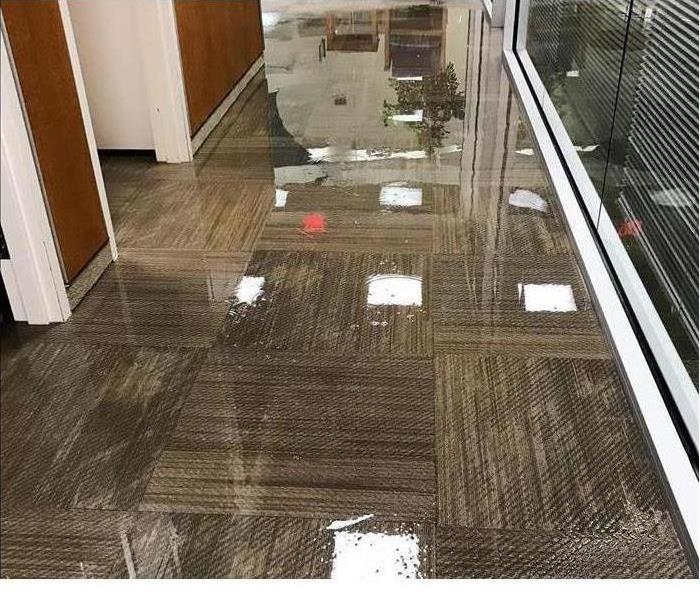 Standing water in commercial office building
Standing water in commercial office building
As we move into the colder, wetter months, we all have to consider the possible damages that our structures can sustain during this time of year. Summer’s storms are past, and now from leaky roofs and moldy siding to deep ruts in the driveway or potholes in the parking lot, the fall and winter months will bring their own set of concerns to both home and business owners. Weather won’t be as violent, but rains can last a lot longer, and then will come sleet, ice, and snow.
For the homeowner, some of the exterior concerns due to weather will be:
- Eroded landscaping
- Rutted driveways, especially those that are graded either up or downhill
- Moldy siding, window sills, door-jambs, window panes, and roofing
- Rotting wooden fencing and decking
- Leaking roof
- Puddles and pooling
For the business owner, some of the exterior trouble spots can be:
- Potholes and eroded surfaces in public parking areas
- Eroded walkways or damaged, buckling sidewalks and public walkways
- Leaking roofs
- Damaged materials and machinery that have not been stored properly
When it comes to the interior spaces, businesses have to keep an eye on employee bathrooms and kitchen/break areas to make sure that leaks are handled immediately and that spills are cleaned up right away. During bad weather, customers and vendors will track water and debris into your building, and both for safety and aesthetics, it will be a good idea to keep up with this type of accumulation to prevent water damage. Have an umbrella stand ready for everyone who comes through the door!
Homeowners also need to keep up with spills, leaks, and traffic, but it will obviously not be such a large job. In a home, water damage is more likely to come from a water heater or dishwasher that is malfunctioning, or a washer that has developed an issue.
One thing both types of structures have to be concerned about is mold, however - it is never a good thing to realize that a colony has taken hold in either your home or your business.
The team at SERVPRO of Grapevine/NE Tarrant County is experienced in all types of clean up after water damage to both homes and businesses, and mold remediation is one of our specialties. Call us today at (817) 595-2506!
Dealing With Water Damage in your Attic
10/2/2020 (Permalink)
Considering the attic isn’t an area that is used often by homeowners, it’s easy to forget about it. This is the main reason water damage in the attic often goes unnoticed. If water damage isn’t addressed, it can cause more damage to the areas below the attic and potentially cause mold. The signs of water damage usually include water stains, mold, or musty odors in your home. It is important to make sure you take the proper steps to assess the damage as soon as you notice in order to assure your safety and health, and avoid expensive repairs.
In order to address the damage, you must first find the source of the problem. Begin by evaluating the damage. Where is the water coming from? Could it be a burst pipe or a hole in your roof? Make sure to check the roof for leaks on a regular basis. The water damage in your attic can also be caused by a lack of ventilation. Humidity can get trapped in the attic and cause a buildup of condensation, which causes water damage. Be sure to remain safe throughout this process and turn off all electrical items before touching anything.
The next step is to inspect for mold and fix any leaks. As previously mentioned, water damage can lead to a more serious issue, mold, and mildew. Mold can grow in as little as 24 hours, and it’s easy for it to go unnoticed. When inspecting for mold, it is important to take the proper precautions and be careful. Some mold is toxic to humans and if the mold is a serious issue rather than a small one, it’s best to contact a professional. It is also advised to contact a professional before attempting to fix any leaks unless you have to tools and skills to do so with ease.
SERVPRO of Grapevine/NE Tarrant County is always ready to help and assist you with any water damage or mold you may have! If you’re in over your head with water damage, give us a call at (817) 595-2506.
Top Three Spots to Check for Water Damage in your North Texas Home
9/25/2020 (Permalink)
Catching water damage before it becomes evident can save you time and money, so knowing the top spots in your home to regularly monitor for damage is crucial for any homeowner. Instead of waiting until a water stain appears on your ceiling or water pools on the floor under your sink, make it a priority to inspect these three spots for water damage on a monthly basis.
- Check under the sink.
Sinks are regularly located in your kitchen, your bathrooms, and maybe even in other rooms in your house. Since water flows from the faucets and comes up through pipes underneath the sink, it’s not uncommon for leaky sinks to occur. Always inspect the cabinetry and piping underneath your sink for any leaks or moisture.
- Don’t forget to look behind the toilet.
Your toilet is another frequently-used appliance in your home that uses a lot of water with every flush. Monitoring the space behind and around your toilet for any water damage is always a good practice.
- Take a look at your roof.
It’s easy to forget to look at your roof for water damage, but if your gutters aren’t working properly or your roof isn’t in good shape, there’s a fair chance that water may be seeping through your roof into your attic, your garage, and your ceilings. It can be hard to know what to look for, but any obvious water stains are a bad sign. Be sure to check out the roof from the exterior and the interior sides (your ceilings).
Water damage can be costly and affect the structural integrity of your home, and so it’s important to keep an eye out for water damage before it wreaks havoc. If you’re looking to buy a new home, here are a few things to look for to ensure that you don’t prematurely buy a home that’s susceptible to water damage.
If you recognize the signs of water damage on one of your regular rounds inspecting the vulnerable areas of your home, contact SERVPRO of Grapevine/NE Tarrant County at 817-595-2506. With state-of-the-art technology and training, our disaster restoration professionals are equipped for handling the job.
Water Damage Restoration Protocol Steps
7/24/2020 (Permalink)
Water and mold damage can be very destructive to your home or business. The most important thing to remember in case of a flood is to act quickly. First, call your insurance company to see if the damage is covered. Most insurance agents or adjusters will recommend a reputable and approved restoration company to do the clean-up. Find out if you have a deductible and know what it is. If you do not have insurance the first thing you must do is dry out your basement.
If water is left longer than 48-hours, it can be considered hazardous and the cleanup process can turn into a much bigger expense.
The following clean up steps are the proper protocol:
- Extract the water and find the source of the problem.
- Remove any contaminated materials including carpet, drywall, boxes, and anything else that might have gotten wet. The level of saturation in the amount of time and materials were exposed to the water will determine if the items are salvageable.
- Place air-movers and dehumidification equipment throughout the flooded area. Keep them on until the basement and crawl space is thoroughly dry. This may take 3-5 days.
- Do not replace or remove any of the unsalvageable materials until your insurance adjuster has deemed them unsalvageable. Make sure all your items are free of mold before moving them to a dry area of the home.
If you find mold in your basement or crawlspace or there are signs in your house like a musty smell, you may need to have the air tested. This test should be conducted by a certified inspector and sent to an accredited lab for analysis.
If you have a water or flood damage to your home or business, SERVPRO of Grapevine/Northeast Tarrant County has emergency services 24 hours a day – 7 days a week! Our crews are highly trained to remove the damaged materials and begin the restoration process using specialized equipment to determine the wet areas, extracting any standing water and placing fans and dehumidifiers to remove all excess moisture to restore your home to “Like it never even happened."
Call SERVPRO of Grapevine/Northeast Tarrant County, your local water restoration and cleanup company at 817-595-2506.
Residential Water Damage Restoration Case Study: The Newlywed Nightmare
4/13/2020 (Permalink)
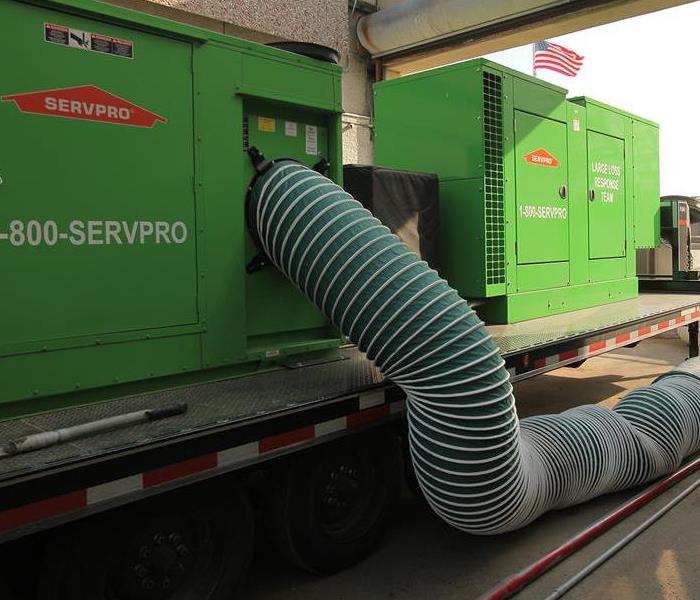 Here to Help
Here to Help
Summary: SERVPRO of Grapevine/NE Tarrant County used a hypothetical case study to help people understand the importance of knowing who to call after a water damage emergency.
A functional plumbing system is something that many people take for granted. It is expected that when a faucet is turned on the water flows out and when the faucet is turned off the water stops flowing. Homeowners may have never considered the possibility that their plumbing may malfunction and if that possibility occurs, they may not know how to react or who to call. SERVPRO of Grapevine/NE Tarrant County has ample experience in dealing with residential water damage from plumbing emergencies and other disasters. Over the years the team of restoration experts has come to the rescue of many water damage situations. Analyzing a case study can help people anticipate a water damage emergency and create a response plan should such an emergency take place. Consider the following hypothetical scenario.
A pair of newlyweds have worked tirelessly to have their new home ready and waiting for them when they return from their honeymoon. On the day of their wedding, they made last-minute preparations at their new home including having a plumber connect their plumbing to the city water. Not giving a second thought to the plumbing, the couple enjoys a flawless wedding and a romantic honeymoon.
Excited about their new home, the newlyweds decided to return from their honeymoon a few days early. As they turned into their neighborhood, they noticed a stream of water along the edge of the street. The newlyweds thought that perhaps someone was washing a car or watering their lawn or maybe the city is flushing a fire hydrant. Only when the couple pulls into their driveway that they discover the source of the water. Water is pouring out from under their new home and cascading from under the front door. The kitchen floor buckles and anything touching the floor is wet and saturated with water. What had happened to their dream home?
To their horror, the newlyweds discovered that the plumber had connected the water line but failed to thoroughly check all the connections inside the home. As a result, the waterline to the ice maker had been irrigating the carpeting for almost four days.
Immediately the newlyweds shut off the electricity and the water meter and tightened the connection to the ice maker so that the deluge would stop flowing. They assessed the extent of the damage and took lots of pictures with their smartphones for documentation. After unplugging fixtures and appliances and rescuing sensitive electronic equipment including computers and gaming systems, the newlyweds called their insurance agents. But the couple is still faced with a massive problem. Cleaning up is far beyond their capabilities. What would they do? Where do they go from here? Who would they call?
A situation similar to the above scenario is not uncommon. Whether it's from human error, a burst pipe, or a malfunctioning household appliance. Millions of people experience some kind of water damage emergency each year. If people do not have a plan in place, they can be met with mountains of stress and anxiety. However, if homeowners have a trusted water damage restoration specialist they can turn to then they can minimize stress and quickly get back on their feet.
Thankfully, the newlyweds knew to call their local SERVPRO to help manage the effects of the flooding. Realizing they need professional help, the couple called their local SERVPRO to begin the process of cleaning up the mess and restoring their home to its original condition. Though it was after hours, a real person answered the phone and assured the couple that a crew would be on the scene in about an hour. The operator reassured the newlyweds that everything would be fine. She gave them some further safety tips and provided instructions on how they could prepare for the arrival of the crew.
In less than an hour, the SERVPRO restoration specialists arrived and the team performed a thorough water extraction process removing any contaminants and preventing the growth of any mold. Their strong but safe vacuum system extracted water without harming the carpet or flooring. Because many building materials retain water, SERVPRO dried and dehumidified the home once all visible water was extracted. The house was then cleaned and sanitized and odors were removed. This process was especially important to the couple since the husband had asthma and the wife was allergic to mold. Until the SERVPRO team was finished, the newlyweds headed to the nearest hotel. Finally, SERVPRO restored their home so well that the house looked like the water damage never even happened. Although the water damage experience was not something they expected or wanted, they had peace of mind knowing that their home was in good hands.
For more information about water damage restoration services, contact SERVPRO of Grapevine/NE Tarrant County at (817) 595-2506.
Flood Damage Remediation for your Grapevine Home
3/30/2020 (Permalink)
Floods can be highly destructive to your home, as water can seep into every corner and crevice of your home. It goes through rooms and walls, creating lasting and permanent problems unless it is treated adequately and quickly. To effectively mitigate and repair flood damage, you need the trained professionals at SERVPRO to come to your home and help you.
At SERVPRO, we offer highly qualified flood damage repair specialists who are here to work with you to restore your Grapevine home back to its previous state before the flood. We have a nationwide network of experts to make sure you are served in a timely fashion, by technicians who are familiar with your local area and the local building codes. Our flood damage repair services give you a comprehensive range of repair and cleanup service, covering everything from the removal of standing water to total restoration and reconstruction.
RAPID STRUCTURAL DRYING
Our services include the fast drying of your structure which saves you as the property owner and your insurance company time and money. Rapid drying is safer, healthier, and provides less inconvenience for you and your family. It also minimizes the replacement of expensive structural materials. This process is also less disruptive and brings less stress during the remediation process.
FURTHER REMEDIATION
After the visible water is extracted, SERVPRO experts start developing and planning for the places that are unseen – such as insulation, drywall, beams, framing, and ceiling tiles. Even if the room looks like it is dry, mold can begin growing behind walls and on the wood where you cannot see it, causing major problems down the road. Issues that insurance will no longer cover.
Our certified technicians are IICRC trained, following approved standards. We have a full range of equipment on hand, such as diagnostic equipment, desiccant dehumidifiers, low grain refrigerant dehumidifiers, and thermal imaging equipment.
Our fast response and experience in flood damage repair make us an easy choice in restoration repair. We also help you converse with your insurance company to get your flood damage claim settled quickly and with the least stress possible on your part.
LOCALLY OWNED COMPANY WITH NATIONAL RESOURCES
After your home has suffered from flood damage, SERVPRO of Grapevine is ready to help you at any time. All you have to do is call our team at 817-595-2506, and we will quickly send out professional staff to create a plan of remediation for your home or business to get your life back to normal as soon as possible.
Understanding Water Types
3/30/2020 (Permalink)
When your home or business suffers a water damage, understanding what type of water you are dealing with is critical to ensuring proper cleanup.
There are three types of water.
- Clean water (Category 1) is water from a broken pipe or any other CLEAN water source; rainwater is also considered clean.
- The term gray water is used to classify slightly contaminated water (Category 2). Clean water becomes gray water when it is left untreated for too long, causing bacteria to other contaminants to begin growing, making the water hazardous.
- Black water (Category 3) is highly contaminated and filled with fungi, bacteria, chemicals, human waste and more. Black water is typically caused by sewage backup, storm flooding, or any other type of natural disaster. Black water should always be handled by trained professionals.
Consider taking the following precautions to help minimize damage or prevent further damage while waiting for SERVPRO of Grapevine professionals to arrive:
DAMAGE FROM CLEAN WATER
- Shut off the water source if possible or contact a qualified professional to do so.
- Turn off circuit breakers for wet areas of the building if access to the power distribution panel is safe from potential electric shock. Do not enter rooms with standing water, as electrical shock hazards may exist.
- Remove as much excess water as possible by mopping and blotting. Wipe excess water from wood furniture after removing lamps and tabletop items.
- Remove and prop up wet upholstery cushions to allow even more drying.
- Move any paintings, art objects, computers, documents and other valuable items that may be sensitive to moisture, to a safe place.
- Do not leave books, newspapers, magazines, or other colored items on wet carpets or floors as they may cause staining.
- Do not use your household vacuum cleaner to remove water. You will destroy your vacuum cleaner and will most likely cause electric shock in the process.
- Do not turn on ceiling fixtures if the ceiling is wet; do not enter rooms where ceilings are sagging from retained water.
DAMAGE FROM CONTAMINATED WATER
- Avoid all contact with sewage and items contaminated by sewage. Wash your hands THOROUGHLY if you come in contact with contaminated items.
- Do not walk through contaminated areas, as you could spread the damage to unaffected areas of the home or business.
- Do not turn on the HVAC system is there is a possibility of spreading contaminated air.
- Do not use household fans to dry the structure; air flow could spread contaminants.
- Discard any food and/or products for personal hygiene and cleanliness if exposed to the contaminated areas.
A Water Damage Timeline for your Fort Worth Home
3/20/2020 (Permalink)
Water Damage Timeline: Reasons Why You Need to Act Promptly
The last thing you'd want to greet your eyes when you come home from work is a soaked-up floor. Water damage in Fort Worth can happen in a jiffy. Now picture the extent of damage that can occur after leaving for a month-long vacation? A leaking hose in the home can send water spewing everywhere in the house, and it only takes a matter of minutes for the moisture to seep through the porous elements and fixtures, causing damage. If left unchecked, the water may accumulate inches above the floor, and that may put the structural integrity of the property at risk.
When your residential or commercial property remains exposed to water without any intervention, destruction follows. That's the reason householders are always advised to react promptly when faced with such an emergency. The following is a comprehensive discussion about water damage timeline and how to alleviate destruction by moisture.
Within a Few Minutes
If water flows uncontrollably from a sink faucet or a broken hose, it takes a few minutes for it to start ruining your stuff and valuables. It spreads all over the floor, saturating every surface it comes in contact with. These include walls and carpets. The once-fine polish on the furniture may bleed off while different dyes may stain other surfaces.
While stagnant on the floor, water may also reach books, papers, photo albums, and other critical documents. Water seeps into them and causes them to warp and become soggy.
Water Damage After Hours
Assuming you were out for the entire afternoon when the washing machine pipe breaks. From the first hour to 24 hours, several kinds of damage will have occurred. The interior will start reeking of an intensified odor. Drywalls may begin to swell and might even break down. Any metallic items or surfaces that come in contact with the water start to tarnish. In the kitchen area develops a musty and damp atmosphere.
Wooden flooring materials and sections of furniture that the water touches also get ruined within hours. Laminated wooden fixtures may swell ad the outer coating may get cracked. Dyes from napkins and colored decorative papers may spread all over the place, causing surfaces to stain.
Extent of Damage within 48 Hours and One Week
If a faulty faucet spirting water on the floor does so for two days or beyond, mold patches begin to grow in moist areas. The water also sips into wooden doors and windows and makes them warp. In some cases, opening and closing these apertures may become challenging.
Wooden flooring material begins to buckle, while surfaces attached using adhesives start to peel off, breakdown, or release. The home may pose health risks to persons with respiratory conditions or weak immunity. Asthmatic individuals also experience increased sensitivity due to the high rate of allergens and mold growth.
Expected Water Damages Beyond a Week?
Following torrential rains, your unoccupied holiday property may lack someone to take care of the flooded house. If control measures are not taken, water damage Fort Worth spreads to the entire property, leading to contamination. At such a juncture, homeowners incur higher restoration costs because of the need to rebuild the structure and removing contaminated stuff.
The home becomes unfit for occupancy because the extent of water damage has taken hold of the critical fixtures and elements of the property. The structure has become weak due to the wooden shell soaking too much water.
Practical Water Damage Prevention Tips
Carrying out preventative maintenance projects in your home, both inside and outside, helps you alleviate water damage. Below Are some of the critical areas that you need to focus on when scheduling for your maintenance routines.
1. The basement
Water damages may, at times, occur because of seepage in the basement. Cracks in the foundation would be the most probable cause. If you start noticing that water seeps into your home when you never experienced that, it should signal that your once water-proof cement has become weak by developing fissures. The next thing you can do to control the damage is to use a water sealant to the cracks to avert seepage.
Additionally, you need to ensure that the water flows away from the building whenever it rains. Seepage becomes further intensified because the landscape may be slanted in a way that ground runoff flows towards the home. You need to make sure that you patch up sections of the surrounding soil to prevent water contact with the foundation.
2. Plumbing System
Always make a point of inspecting the connection of your home, including drains and faucets that facilitate water flow from fixtures such as washing machines, ice makers, water heaters and dishwashers. Some homes have water-leak sensors that provide alerts whenever seepage is detected. Once you get the feed, identify the pipes that have leaks and replace them for efficient flow.
You may also want to check the pressure of the flow within the drains regularly. Under high pressure, pipes and hoses may burst. You can prevent that by investing in a pressure gauge and fit it in the faucet located outside the home. Turn the faucet to release the highest pressure. The reading you get on the gauge indicates the pressure of water inside your residence. Most homes in Fort Worth have pressure systems set between 40 – 70 psi. Whenever the force goes beyond 100 psi, you need to purchase a pressure regulator in your local hardware.
Are you planning on going for an extended vacation? Make sure you shut off the water flow to the washing machine. Also, remember to switch off the dishwasher.
3. Prevent Damages to Your Belongings
Sometimes your house may be cluttered with too much off-season stuff. Protect them by storing them inside water-resistant bins, most so in damp areas where pipes are fitted. That includes the basement and the attic.
Store your storybooks, photographs and other memorabilia in areas less vulnerable to water damage in Fort Worth. Construct shelves to store these items. You can also have shelves in the basement to create storage space, instead of leaving them on the floor where water seepage may cause the growth of mold colonies on them.
For all your water damage needs, give us here at SERVPRO of Grapevine/NE Tarrant County a call at 817.595.2506!
Fort Worth Washing Machine Maintenance
3/10/2020 (Permalink)
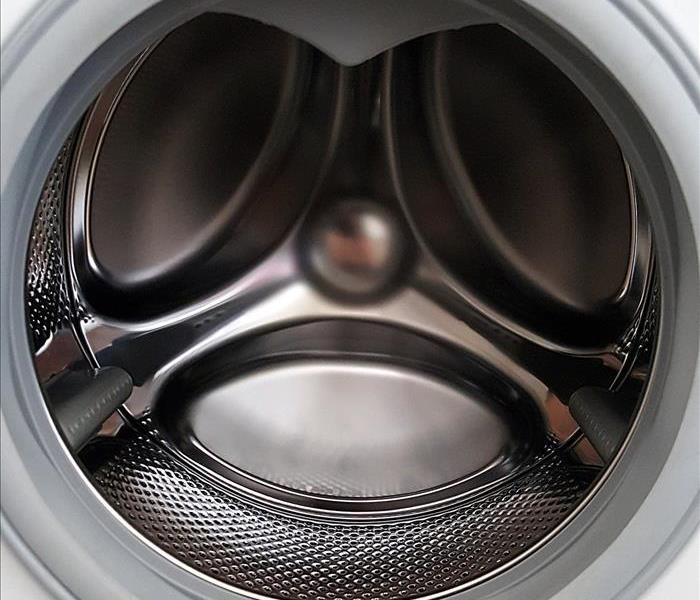 Taking care of your washing machine is important so you can avoid water damage.
Taking care of your washing machine is important so you can avoid water damage.
Do you know how many gallons of water your washing machine can hold? On average, a single washing machine can hold 15 to 30 gallons water. Now, think of how many times your washing machine drains, and then refills during a cycle it’s usually around two, right? That means – depending on the settings you have selected – your washer can use anywhere from 45 gallons to 90 gallons of water in just one wash. Now, think about if your washing machine somehow malfunctioned, and you didn’t have any idea that it happened. It would definitely dump a lot of water all over your home. What’s worse is that insurance may not even cover it because it could be considered something along the lines of “failure to maintain” which we will definitely cover in a later blog on just what that means. So, what can you do to make sure your washing machine doesn’t fall apart, and you don’t end up with a massive puddle in almost all the rooms of your home?
Taking Care of Your Washing Machine
With the next week going to feel like spring here in Fort Worth, it is enough to make anyone want to get out and get to work on their spring cleaning and maintenance out of the way while it’s nice; and before it gets too hot here to do anything but sit on the couch with the air conditioning on a high and a tub of ice cream. While you’re cleaning your gutters and cleaning out your garage, maybe take a peek at your washing machine one day to see how it’s doing maintenance wise.
- First thing is first, inspect the hoses. Failing hoses is probably the number one source of water damage when it comes to washing machines. Make sure to check for bulges, cracks, and make sure the fittings are secure. Replace anything that looks concerning, and maybe consider a metal hose instead of a rubber or plastic one.
- Have you washed your washer? That sounds weird, but it’s imperative to wash your washer to make sure your laundry stays clean and fresh. Just run an empty cycle with a load of hot water and about two cups of white vinegar. Then in the middle of your cycle, add in about a half cup of detergent.
- After you’ve washed it, make sure to wipe down your drum, your door, and the rubber gasket that lines your washer door. This will ensure that your washer won’t give off any gross odors.
It’s probably wise to inspect the hoses at least every six months and do the general cleaning about once a month to keep your machine fresh and to keep it from stinking up too much. Some other general washing machine tips are:
- Use the right type of detergent. Believe it or not, your washer could use a special type of detergent. Check the right kind in your washer instruction manual.
- Make sure you’re using the right amount too, too much will leave a residue, and nobody wants to have to clean that.
- Raise your hand if you’re guilty of leaving your laundry in your washer for an extended amount of time and forgetting to put it in the dryer. If you’re very guilty like me and find that your clothes have turned a bit mildew-y, do about a splash or two of white vinegar in your clothes and rewash with your normal amount of detergent. It’ll take away that mildew smell easily.
And that’s it! Washing machine maintenance is important to keep potential water damage emergencies at bay. If you do find yourself with a water damage emergency in your Fort Worth home, give us a call today at 817.595.2506!
We've Got Your Back When It Comes To Restoring Your Fort Worth Home From Water Damage
2/7/2020 (Permalink)
When water damage hits your Fort Worth home, are you prepared? The answer is often no, a water loss in your home can be incredibly stressful and can lead to a situation where panic definitely is at the forefront of your mind. It’s important to take a deep breath, and call us here at SERVPRO of Grapevine/NE Tarrant Co! We can handle any size job, and have the training and the know-how to make sure that your job is handled with the care and attention needed to make sure that your lives get back to normal. Water damage happens in an instant, let us help you fix it just as fast.
Give us here at SERVPRO of Grapevine/NE Tarrant County a call today at 817.595.2506 for all your water damage restoration needs.
Fall Water Damage Prevention
10/13/2019 (Permalink)
I took a trip through Oklahoma this last weekend, and it was amazing just a quick trip up north could yield such a drastic change in weather. We were traveling through the state fairly early in the morning, and the amount of frost on the grass and fields was really impressive! It was an exciting thing to see - mosquitoes are the bane of my existence after all. But it also made me run through a list in my head of all the things I need to do in preparation for the winter weather that’s inevitably coming our way.
And it’s a good thing for all of us to think about. Winter is one of our busiest times here at SERVPRO of Grapevine/NE Tarrant Co, not only do we get a frequent amount of rain, but we are usually ill prepared for freezing pipes. It doesn’t often get down below freezing here in the Fort Worth area, but when it does, it often times spells disaster for unsuspecting homeowners.
So, while it’s still nice and mild out this next week, be sure to do some routine maintenance on your home, such as checking your roof for potential leaks that have may have popped up over the summer, ensure that your exposed pipes are properly insulated, and make sure to turn off your sprinkler system.
If you find yourself in a wet situation this fall, give us a call today at 817.595.2506!
Water Damage To Your Fort Worth Home? No Problem!
5/23/2019 (Permalink)
 On the job!
On the job!
Has a pipe leak, or the recent rains caused water damage to your Fort Worth home? No worries! SERVPRO of Grapevine/NE Tarrant County is “Here to Help!” We are on standby 24 hours a day, 7 days a week to make sure that your water loss emergency is handled immediately no matter what. Even if it’s in the middle of a fireworks show on the 4th of July we will be there. It doesn’t matter the size or location either, whether it’s your home or your 1000 square foot warehouse we’ve got the equipment, manpower, and training to get the job done right and done right every single time. Our reviews prove that.
If you’ve found yourself with water damage, give us a call today at 817.595.2506!
Are You Ready For Rain?
5/8/2019 (Permalink)
Are you feeling a little water logged? We certainly here are at SERVPRO of Grapevine/NE Tarrant County! But we aren’t complaining, we love the spring time and the thunderstorms that come with it. You could consider us weather geeks. But with all that rain, does come flooding and water emergencies. Be sure to check up on your insurance policy to see what is and isn’t covered when it comes to outside water – most of the time it isn’t covered unless you have special add on plans. And we cannot stress this enough: maintain your home! That is the surefire way to make sure that you don’t have an unexpected water emergency.
If you do find yourselves under water this spring, give us a call today at 817.595.2506!
A Water Damage Timeline
5/7/2019 (Permalink)
Water damage in Fort Worth is no joke, did you know that there is a very specific timeline to water losses? A timeline that is crucial to getting your home back to normal – it’s why we take every water loss seriously and act as quickly as we can. Within minutes your home can be completely saturated with water, it will absorb into walls, belongings and floors. Within the first one to two hours, dry wall begins to break down and swell, furniture can crack and swell. Skipping ahead 48 hours, mold and mildew may have begun to spread and grow along floors, walls and furniture. Depending on the type of water loss, biohazard contamination is possible.
The damage to your home is incredibly fast, which is why it’s important to call us immediately at 817.595.2506!
Spring Water Damage Checklist
5/3/2019 (Permalink)
That’s been some rain we’ve been having, and with the flash flood watch extended into tomorrow, we will be seeing more. Water damage to your home is rampant this time of year, it’s our rainy season after all! It can be incredibly unexpected and scary which Is why we make sure to always be ready to roll out and help you with whatever problem your having.
With the rainy days, comes the wonderful nice weekends, however! And it’s important to do your general spring checks on those weekends as well. Make sure all your supply lines to washers and refrigerators are in working order and not worn – replace any that are. Inspect your roof for damages from the last hail storm we had, and repair accordingly. Check your door jams and window seals too, so water can’t sneak its way in.
If you’ve found yourself with a water damage problem, give us a call today at 817.595.2506!
We're "Here To Help."
5/2/2019 (Permalink)
With the storms rolling in through the rest of the week, it’s important to remember that we here at SERVPRO are always “Here to Help!” No matter if it’s an overnight storm that has caused a huge leak in your roof, flash flooding that flooded your dining room, or just a small leak that’s caused some damage to your flooring. We are ready to go. It doesn’t matter the time of day, nor the day of the week we will always be ready to answer your call.
We are ready to head to your water loss as soon as you hang up the phone, so you can rest easy knowing that the unexpected will be dealt with in a timely manner. Just give us a call today at 817.595.2506!
What's Covered By Insurance?
4/30/2019 (Permalink)
When you’re dealing with water damage, do you know what and what isn’t covered by insurance? Here’s a quick guide to what may or may not be covered by your insurance.
Drain or sewer line?
No. This isn’t covered by insurance unless you’ve got extra coverage. You maybe dealing with the city on this one.
Roofing?
This one is both a yes and no answer. It’s done case by case and can be pretty confusing. If it’s a small and gradual leak, then it probably won’t be covered but if it’s something like hail damage that caused huge hole in your roof will be covered.
Pipes?
Also on a case by case situation, if your pipe suddenly bursts then your insurance will most likely be covered by your insurance. If it’s a slow continuous leak – most likely not. That’s not covered because it was a failure to maintain.
Appliances?
Sorta. Again, this falls under the failure to maintain umbrella. If it’s a maintenance issue you’ve known about and haven’t done anything to fix it won’t be covered if it’s a sudden and unexpected incident, then it’s more likely to be covered. Be wary though, the appliance itself will most likely not be covered and that’ll have to come out of your pocket.
Long story short, if it’s a maintenance issue that hasn’t been addressed, it will NOT be covered. If it’s a sudden event it maybe. It’s best to check with your insurance provider if you’re unsure.
For all your water clean up needs, give us a call today at 817.595.2506!
What Happens When I Have A Water Damage?
4/26/2019 (Permalink)
Nobody likes the unexpected – it can be scary and overwhelming and worse case, time and cost consuming. That’s why we here at SERVPRO of Grapevine/NE Tarrant Co. try and ease the blow of the unexpected. We are a team of highly trained individuals with specialized equipment, tools, and skills needed to make sure that your water damage is taken care of properly and swiftly.
What can you expect when you give us a call then?
One of our ladies in the office will first take your call, we’ll take your name, number, and address down and then ask detailed questions so we know exactly what your situation looks like. As soon as we hang up the phone with you, we are dispatching a team out to your home and business so they can be on site as soon as possible. You will also be assigned an admin within the office to take care of your job – they will give you updates, and work with your insurance provider.
Once we get to your home, we will extract any standing water that needs to be extracted using either a hand held extractor or an extractor that we can ride on. We will then place fans and dehumidifiers to help with the drying process.
The next few days we will continue to monitor the drying process and we will drill holes and pull baseboards if necessary.
If you find yourself with an unexpected water loss give us a call at 817.595.2056!
We're here to help with your water loss
4/26/2019 (Permalink)
Water damages happen without warning. They happen when you’re away on vacation, when you’re sleeping, or while you’re at work. They happen when you least expect it and when you’re least prepared. That’s why we are. Here at SERVPRO of Grapevine/NE Tarrant County we are prepared for no matter what happens in your home or business and we are ready to act no matter the time of day – or even the time of year.
We know that time is precious, and so we are on our way to your home as soon as you call us. We are highly trained individuals with the tools and equipment to make sure the job is done right every time.
So if your Fort Worth home gets hit with unexpected water damage, give us a call today at 817.595.2506!
Is My Fort Worth Water Damage Covered?
4/24/2019 (Permalink)
This storm system moving through this week is real killer – we’ve already had so many calls and we know that more are just going to keep coming in. We want to make sure everyone is aware as to what is and what isn’t covered by home owners insurance.
If you’ve had outside water come into your home, then that is considered flooding and won’t be covered by insurance unless you have flood insurance which can be required in most states if you’re in an area prone to flooding.
If you’ve had just general water loss, then that will most likely be covered by your insurance and you won’t need to worry. It’s always a wise idea to call your insurance agent and get a claim number no matter the loss, though.
If you’ve suffered water damage from this week’s storms, give us a call at 817.595.2506!
Washing Machine Maintenance
10/15/2018 (Permalink)
Washing machines are our best friends! They take all the hard work out of doing laundry and allow us to sit and relax while we watch Sunday football, however did you know that washing machines failures are one of the most common was your home can flood? It’s true! While there are many different ways water from a washing machine to cause damage is the main reason is the water supply hose.
To keep from experiencing unexpected water damage in your home, you should be sure to do routine inspections of your supply lines. If the line is loose, tighten it up a bit. Look for any worn tubing or cracks and any worn hoses should be replaced. A good rule of thumb is to replace your supply line every five years, even if you don’t see any visible sign of wear. Try and upgrade to a braided steel one, as they’ll last longer and can hold up to more.
If you’re going to be away from your home from any length of time, you should shut off the valve to make sure nothing can happen by accident while you’re away.
If you have had any water damaged caused by an appliance, give SERVPRO of Grapevine/NE Tarrant County a call today! 817.595.2506
What is Covered by Homeowner's Insurance for Water Damage - Southlake, TX
5/8/2018 (Permalink)
So, you’ve had something happen that resulted in water damage to your home. Your first thought may be “What does my insurance cover?” Water damage is a tricky subject when dealing with the insurance. You may already know that floods aren’t covered by homeowner’s insurance, but you may not know that water damage coverage comes in many different shapes and sizes.
All insurance is different, and what may be covered on one person’s policy, may not be covered on the other. Talk to your insurance agent to see exactly what is or isn’t covered by your policy. Here’s a breakdown of what is and what may not be covered by your policy.
Appliances – Appliances may be covered, though it depends on the type of damage that occurred. If it’s a sudden and accidental loss such as a hose that connects to your fridge that breaks and floods your kitchen this could be covered. However, if it’s a gradual leak that hasn’t been addressed it won’t be covered by insurance. That’s considered failure to maintain your appliances. Also, be aware that your insurance will not replace the appliance itself – replacement appliances will have to come out of your own pocket.
Pipes – Just like appliances, if a pipe breaks, and it’s an unexpected loss, then your insurance should cover the damage to your floors and walls. However, also like appliances, if it’s a gradual and slow leak (say under a sink) that has been neglected will not be covered because it could have been prevented.
Roof – Roofs are tricky and are often on a case by case basis. While a long-term leak caused by a poorly maintained roof may not be covered, if a tree falls on your roof or high winds blow shingles loose and cause leaks, then the inside of your home will be covered – but not the roof itself. For better understanding about what your policy covers when it comes to roofs, it’s better to talk to your agent.
Backed up drain or sewer line – No. Unless you add on extra coverage, you’re not covered if something gets backed up.
Seepage – Unfortunately, seepage isn’t covered by insurance because it is considered a maintenance issue.
For all your water damage needs call SERVPRO of Grapevine/NE Tarrant County 24/7 at 817.595.2506!
Undetected Water Damage in Your Home
5/7/2018 (Permalink)
Water doesn’t have to burst from pipes or come from a bad flood to be a problem in your home. Sometimes, undetected water damage can cause the biggest headache. There are five tells that there’s water damage going undetected in your home.
- Stains on walls and ceilings. – Nobody purposefully looks up at their ceiling. However, it is important to thoroughly check the ceilings in your home for stains. There might be a bath tub or shower leak from one floor to the next, or your ceiling could be leaking into the attic.
- Musty or unpleasant smells – Do you smell something musty, or even earthy, in your home? Hidden water can cause mold to grow, and a nasty smell is a good signal that something is wrong.
- Peeling paint – Not only can water stain your walls, but it can also cause the paint to lift. If you see your paint starting to peel, quickly find the source of the problem, or call a professional to fix it.
- Visual Mold Growth – Just like with ceilings, we don’t exactly pay attention to the corners of our homes, but often these small hidden areas can tell us about potentially harmful leaks or spills. Check to see if there are any discolored or fuzzy looking spots in isolated corners or hidden areas.
- Flooring Effects – When allowed to flow, water naturally seeks the lowest level. This is why rivers flow downstream. Water can seep under your flooring and collect – damaging your sub-floors. Check for and warping or deformation to make sure there is no water hiding beneath the floorboards. When this happens, it is important to act as quickly as possible, so we can restore your flooring to good as new.
If you suspect you have water damage, call SERVPRO of Grapevine/NE Tarrant County now! We are open 24 hours a day, 7 days a week. 817.595.2506
How To Tell If Your Floor Has Water Damage
5/4/2018 (Permalink)
No floor is safe from water damage. Water can seep down to the sub floor or even seep up from a slab leak. It’s pretty easy to tell whether or floor has had any water damage, and with these tips, you’ll be able to spot it fairly quickly. Each floor type has a different set of signs of water damage, so familiarize yourself with all of the signs to prevent unpleasant suprises.
Carpet shows discoloration and an odor from mold or mildew.
Tile which has discoloration could mean it has water damage. Another trick is to tap on the tiles with a coin. If you hear an empty or hollow sound it means the tiles are loose and that it could be water damage.
Hardwood flooring has four main signs that water damage has occurred. The first sign is buckling which means the floor planks have completely removed themselves from the floor under them. Next, are dark spots – which could just be a part of the wood’s natural pattern, but if it’s a fairly new spot it is most likely mold or mildew. Third, is bulging which is when the wood planks bubble upwards and create sort of a crown shape. Lastly, is cupping. With cupping, the planks will have dips in the center and raised edges.
Laminate flooring usually sports swelling around the edges. Warping also occurs when the planks aren’t flat and are cupping or bulging. Discoloration could mean mold or mildew.
Linoleum flooring that is showing discoloration could mean that there is water damage.
If you suspect your floor has had water damage, call us today at 817.595.2506!
Water Damage in Older Homes, Southlake TX
5/2/2018 (Permalink)
Older Homes with Water Damage
I LOVE older homes, especially homes built in the 50s and 60s – I’m a post-modern fan. But, with older homes there is always the risk of finding a multitude of problems, from electrical, to structure, coding, and water. Water is probably one of the worst problems that can plague a home. It can rot out wood and cause dangerous mold. So, how do you tell if an older home has water damage? Here are some common signs:
What’s that smell? Sometimes water damage isn’t always in plain sight, so sometimes you have to make like a dog and follow your nose. Occasionally, some older homes might just have a musty smell due to their age, but if you walk into a specific room and your nose is assaulted by the smell of mold or mildew - more so than normal - then moisture damage is probably lurking behind the walls.
That’s an awfully ugly stain. You can pretty much spot a water stain from a mile away, almost everyone knows what they look like. If you’re purchasing an old home and see water stains or fresh paint in places it shouldn’t be – beware! Ask if the damage was repaired, and require proof to go along with it. If the stain pops up suddenly, get a professional out as fast as you can to see where the water is coming from.
That shouldn’t be crumbling like that. Crumbling wood around your windows and baseboards could mean water has gotten into the wood, making it crumble.
The Buckling. Buckling happens when the floorboards lift off from the sub floor. It is a sign that water has seeped into the dry wall or flooring and has made it swell. You’ll be able to see it and feel it when you walk over the spot; the floor will be warped and will feel as though you are walking over a bump. Get with a professional to determine where the water leak is coming from, and begin repairs before more damage is done.
If you’ve got an older home and have water damage – call SERVPRO of Grapevine/NE Tarrant County today at 817.595.2506.
100-Year-Floods. What are They?
4/30/2018 (Permalink)
Almost everyone is susceptible to flooding, especially those who live in low lying areas near bodies of water – especially during storm season. Flooding can happen at almost any time, and anywhere, in the United States. Coastal cities like Houston or Corpus Christi are especially at risk during hurricane season which happens from June to November, but peaks in August and September. Here in Grapevine/NE Tarrant County, we are more at-risk for flooding during the spring months.
When a flood does happen, you may hear reporters talk about a 100-year-flood, so what is it? We assume that it means the flood of the century. A historical flood only seen once within the last 100 years – even though they can occur two or three years in a row. The 100- year-flood is more about probability than it has to do with historical record.
The phrase ‘100-year-flood’ means that there is a 1 in 100 chance of a flood of that size occurring that year. It was a term made up in the 70's for insurance purposes, and is used to calculate who is required to get flood insurance and who isn’t. If you want to know if you live in a 100-year floodplain, you can check out a map here.
If you happen to live in a 100 year flood plain, and a flood does happen – give SERVPRO of Grapevine/NE Tarrant County a call! We can make it like it never happened with our 24/7 emergency services! 817.595.2506
Water Categories
4/27/2018 (Permalink)
When we deal with water extractions in your homes, you may hear things like “category three” water cleanup, but what do the different categories mean? There are three different categories and each category describes a level of contamination within the water.
Category 1 or “clear water” is water that comes from a clean source such as a disconnected line from an appliance, a water supply line that has broken, or a tub that has overflown. With exposure to other materials, Category 1 water can quickly deteriorate to a Category 2.
Category 2 or “grey water” is water that has come from a source such as overflowed drains from washing machines, dishwashers, or shower and sink, or aquariums. Category 2 water has contaminants that can make you uncomfortable or sick. Much like Category 1, Category 2 water can quickly turn into Category 3.
Category 3 or “black water” is the worst classification of water loss that you can have. Category 3 water is incredibly contaminated water, and contains pathogens, toxins, and other harmful things. This type of water can cause severe illness, or even death, when someone is exposed to it. This type of water’s source can include ground water, toilet over flow with feces, flooding from rivers or streams, and sewer backup.
If you have a water loss, don’t wait! Call SERVPRO of Grapevine/NE Tarrant County today, we answer our phones 24/7! 817.595.2506
Vacation & Water Damage
4/26/2018 (Permalink)
Summer time is right around the corner, which means one thing: vacation. There’s always so much on our minds when it comes to vacations: do we have everything? Do we have boarding passes? What time do we need to leave for the airport? Are the dogs being watched? You double check to make sure everything is unplugged, and ask your neighbors to keep an eye on your house to make sure it doesn’t catch on fire, but what about the opposite of fire? What about water damage?
Most of us don’t think about the possibility of water damage when we are away on vacation. However, nothing would be worse than coming home from the Happiest Place on Earth and finding yourself standing in a few inches of water. Here are some things to add to your pre-vacation check list.
- Shut off the water valve - The easiest way to avoid damage is to turn off your water at the main valve, and we recommend doing this for both long and shorter trips. If you’re not sure where the main water valve shut off is, call your plumber. He can also test to make sure it’s working properly.
- Appliances and more – if don’t want to shut off your main water valve because someone is house or pet sitting, or your sprinkler system is set to run, you should turn off the valves to your appliances like your dishwasher, ice maker, and washing machine.
- Gutters – If you didn’t clean out your gutters while doing your spring yard maintenance, you should do so now. If there’s a sudden summer storm while you’re away, it could unleash havoc on your home.
- Check your insurance policy – if something should happen while you’re away it’s important to double check your insurance policy. Some policies are voided if the home is unoccupied for an extended period. Some policies even have a requirement that someone must check the premises at least once a week.
If you come home from vacation to a water loss, don’t worry! Call SERVPRO of Grapevine/NE Tarrant County at 817.595.2506, twenty-four hours a day, seven days a week!
Removing Water Rings from Tables
4/25/2018 (Permalink)
We’ve covered some heavy-duty water damage topics here on our blog. However, what about the little things? Like water rings on tables, for instance? We’ve all had it happen... a guest doesn’t use a coaster, or your kids simply ignore them. Whatever the case may be, it’s still an unsightly problem. If it’s not too late in the game, however, it is possible to remove water stains from your furniture using a variety of tips and tricks found below.
First off, how do cups stain tables in the first place?
Basically, water rings are a mark left by glasses or other damp materials and the wood absorbs the moisture. Sometimes it’s a cloudiness or a white ring (or dark ring) that is caused by moisture that’s trapped in the finish – which is also the sign of a weak finish. In this case, the moisture hasn’t quite reached the wood yet and has just settled into a layer of finish. If you act quickly – there is hope!
The first thing you can try is hot air. Hot air is one of the best ways to treat water marks that have just recently occurred. You don’t need anything fancy either, a hair dryer will do just fine. Using its lowest – but still warm – setting, move the hair dryer back and forth directly over the mark. This should draw out the moisture in most cases, but just be cautious because it will also heat up the wax finish and melt it slightly. Buff out the area with a soft rag once the water mark has evaporated.
Second is toothpaste. Put a basic white toothpaste on a clean, dry rag and dab it directly onto the stain. This method works by using the abrasive qualities of the toothpaste and water extraction alone. Let the toothpaste sit for a few minutes and then gently rub it along the line of the stain. Be sure not to scrub too hard or go too far out of the stain, and don’t use a gel or a brand with bleaching agents. Both could potentially cause more damage.
The third method you can try is mayonnaise. I know, if you’re like me and you can’t stand the smell of mayo, then this may not be for you. Spread the mayo on the stain and leave it sitting for no shorter than three hours, overnight works best. After it has been left on for the desired amount of time, simply wipe it away.
If you’ve got a white ring that doesn’t respond to any of the above solutions, try using superfine 4/0 steel wool and a finishing product. First pour the finishing product on the stain and then use the steel wool to abrade the surface lightly in the direction of the grain (Be cautious and gentle! You don’t want to damage your table more). Use a towel to wipe away the excess finish. When you’re done with the steel wool, use the finishing product one more time to polish the entire surface of the table. Wipe away the oil and put a clear finish over the top.
If you’ve got dark rings, that means the water has already seeped through the finish and into the wood. Unfortunately, when this happens the above techniques won’t be effective. It may need to be refinished.
For your bigger water problems, call SERVPRO of Grapevine/Ne Tarrant County! We answer the phone 24 hours a day, 7 days a week. 817.595.2506






 24/7 Emergency Service
24/7 Emergency Service

